ERP Systems on Cloud
VerifiedAdded on 2023/04/22
|18
|4994
|260
AI Summary
This research report discusses the characteristics, advantages, and disadvantages of ERP systems on the cloud. It explores the integration of business processes, CRM capabilities, customization, and time-saving features of ERP software. The report also highlights the resource pooling, service quality, and on-demand service aspects of cloud computing technology. Practical case studies and the benefits of cloud-based ERP software are also discussed.
Contribute Materials
Your contribution can guide someone’s learning journey. Share your
documents today.
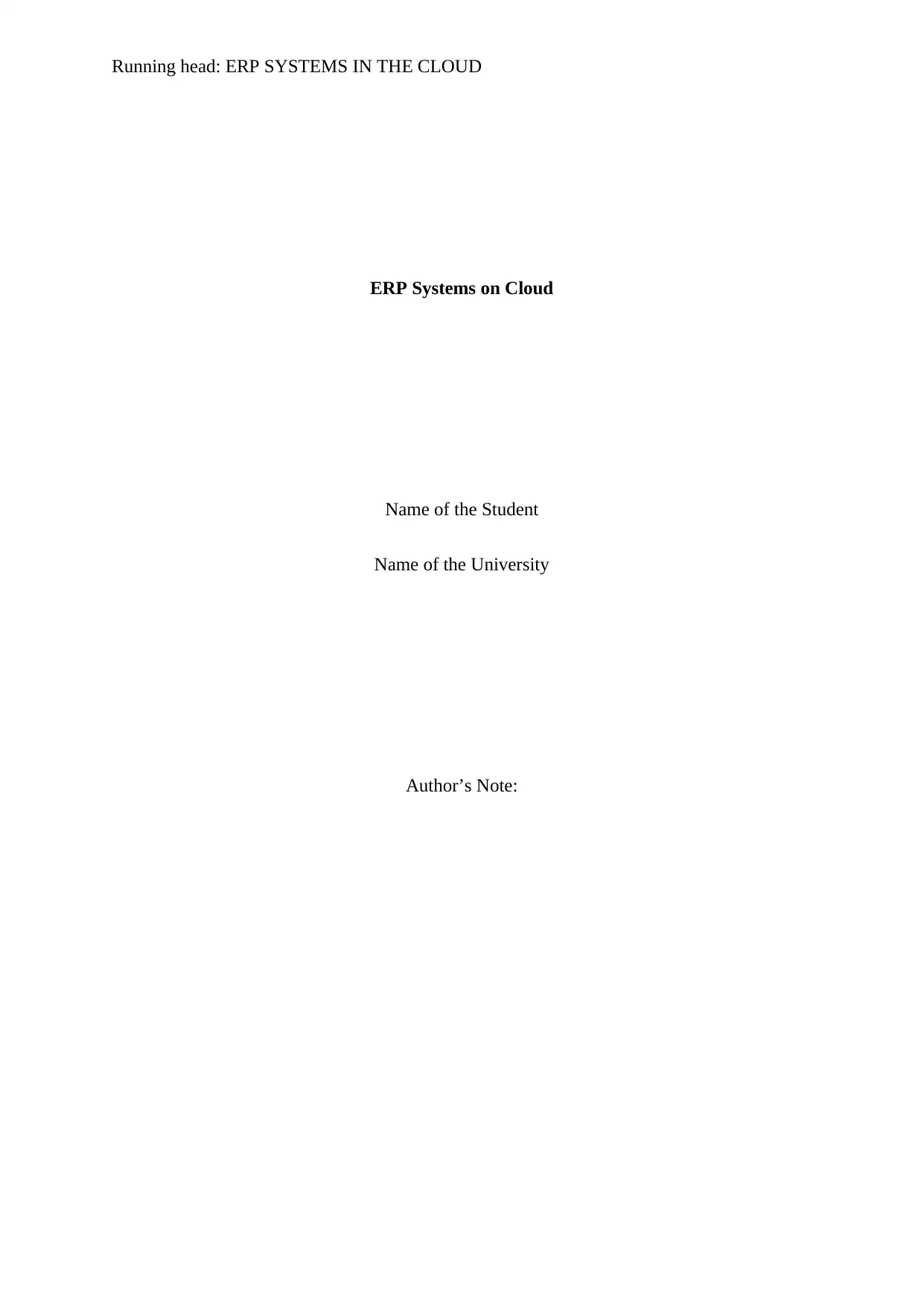
Running head: ERP SYSTEMS IN THE CLOUD
ERP Systems on Cloud
Name of the Student
Name of the University
Author’s Note:
ERP Systems on Cloud
Name of the Student
Name of the University
Author’s Note:
Secure Best Marks with AI Grader
Need help grading? Try our AI Grader for instant feedback on your assignments.
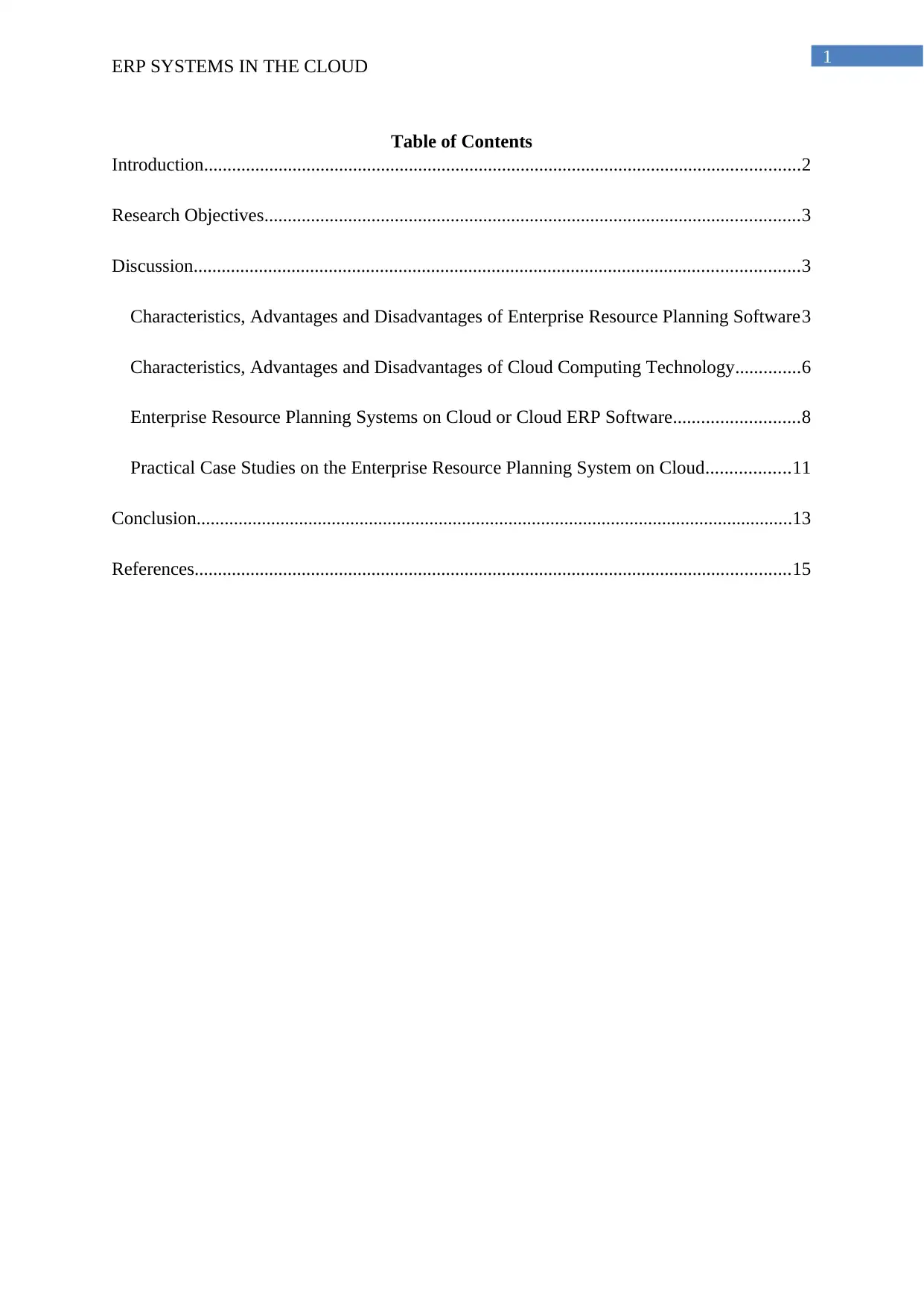
1
ERP SYSTEMS IN THE CLOUD
Table of Contents
Introduction................................................................................................................................2
Research Objectives...................................................................................................................3
Discussion..................................................................................................................................3
Characteristics, Advantages and Disadvantages of Enterprise Resource Planning Software3
Characteristics, Advantages and Disadvantages of Cloud Computing Technology..............6
Enterprise Resource Planning Systems on Cloud or Cloud ERP Software...........................8
Practical Case Studies on the Enterprise Resource Planning System on Cloud..................11
Conclusion................................................................................................................................13
References................................................................................................................................15
ERP SYSTEMS IN THE CLOUD
Table of Contents
Introduction................................................................................................................................2
Research Objectives...................................................................................................................3
Discussion..................................................................................................................................3
Characteristics, Advantages and Disadvantages of Enterprise Resource Planning Software3
Characteristics, Advantages and Disadvantages of Cloud Computing Technology..............6
Enterprise Resource Planning Systems on Cloud or Cloud ERP Software...........................8
Practical Case Studies on the Enterprise Resource Planning System on Cloud..................11
Conclusion................................................................................................................................13
References................................................................................................................................15
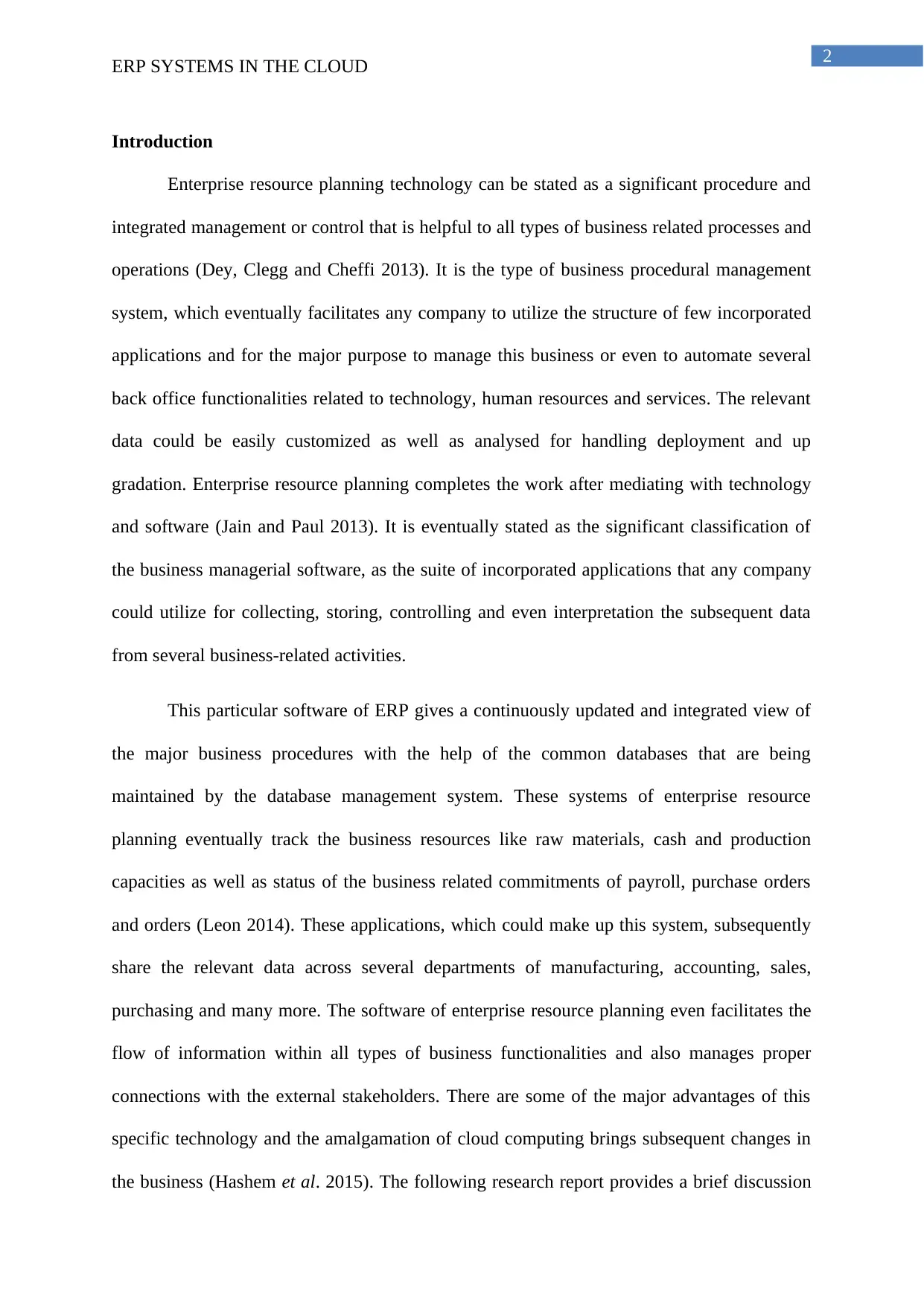
2
ERP SYSTEMS IN THE CLOUD
Introduction
Enterprise resource planning technology can be stated as a significant procedure and
integrated management or control that is helpful to all types of business related processes and
operations (Dey, Clegg and Cheffi 2013). It is the type of business procedural management
system, which eventually facilitates any company to utilize the structure of few incorporated
applications and for the major purpose to manage this business or even to automate several
back office functionalities related to technology, human resources and services. The relevant
data could be easily customized as well as analysed for handling deployment and up
gradation. Enterprise resource planning completes the work after mediating with technology
and software (Jain and Paul 2013). It is eventually stated as the significant classification of
the business managerial software, as the suite of incorporated applications that any company
could utilize for collecting, storing, controlling and even interpretation the subsequent data
from several business-related activities.
This particular software of ERP gives a continuously updated and integrated view of
the major business procedures with the help of the common databases that are being
maintained by the database management system. These systems of enterprise resource
planning eventually track the business resources like raw materials, cash and production
capacities as well as status of the business related commitments of payroll, purchase orders
and orders (Leon 2014). These applications, which could make up this system, subsequently
share the relevant data across several departments of manufacturing, accounting, sales,
purchasing and many more. The software of enterprise resource planning even facilitates the
flow of information within all types of business functionalities and also manages proper
connections with the external stakeholders. There are some of the major advantages of this
specific technology and the amalgamation of cloud computing brings subsequent changes in
the business (Hashem et al. 2015). The following research report provides a brief discussion
ERP SYSTEMS IN THE CLOUD
Introduction
Enterprise resource planning technology can be stated as a significant procedure and
integrated management or control that is helpful to all types of business related processes and
operations (Dey, Clegg and Cheffi 2013). It is the type of business procedural management
system, which eventually facilitates any company to utilize the structure of few incorporated
applications and for the major purpose to manage this business or even to automate several
back office functionalities related to technology, human resources and services. The relevant
data could be easily customized as well as analysed for handling deployment and up
gradation. Enterprise resource planning completes the work after mediating with technology
and software (Jain and Paul 2013). It is eventually stated as the significant classification of
the business managerial software, as the suite of incorporated applications that any company
could utilize for collecting, storing, controlling and even interpretation the subsequent data
from several business-related activities.
This particular software of ERP gives a continuously updated and integrated view of
the major business procedures with the help of the common databases that are being
maintained by the database management system. These systems of enterprise resource
planning eventually track the business resources like raw materials, cash and production
capacities as well as status of the business related commitments of payroll, purchase orders
and orders (Leon 2014). These applications, which could make up this system, subsequently
share the relevant data across several departments of manufacturing, accounting, sales,
purchasing and many more. The software of enterprise resource planning even facilitates the
flow of information within all types of business functionalities and also manages proper
connections with the external stakeholders. There are some of the major advantages of this
specific technology and the amalgamation of cloud computing brings subsequent changes in
the business (Hashem et al. 2015). The following research report provides a brief discussion
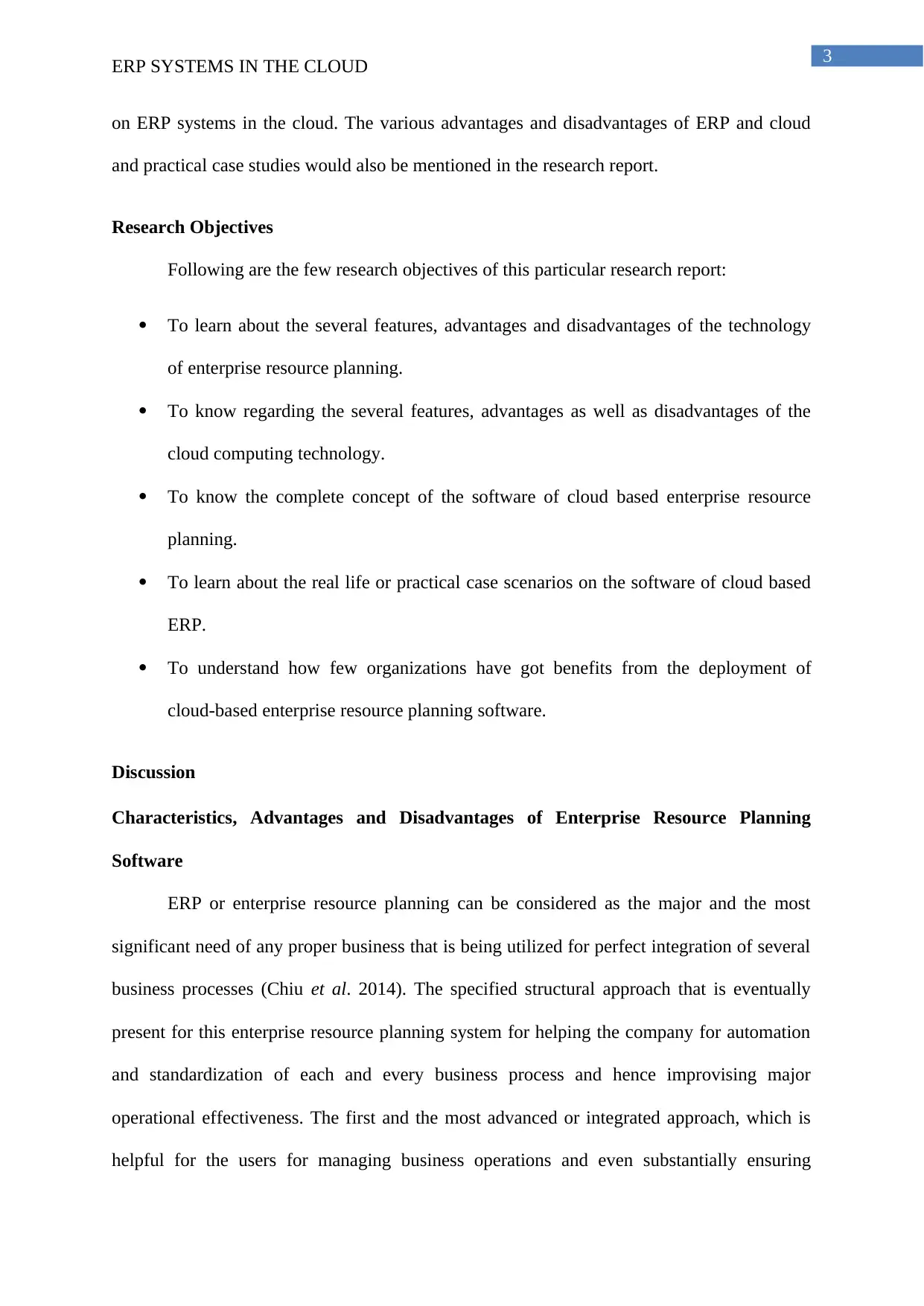
3
ERP SYSTEMS IN THE CLOUD
on ERP systems in the cloud. The various advantages and disadvantages of ERP and cloud
and practical case studies would also be mentioned in the research report.
Research Objectives
Following are the few research objectives of this particular research report:
To learn about the several features, advantages and disadvantages of the technology
of enterprise resource planning.
To know regarding the several features, advantages as well as disadvantages of the
cloud computing technology.
To know the complete concept of the software of cloud based enterprise resource
planning.
To learn about the real life or practical case scenarios on the software of cloud based
ERP.
To understand how few organizations have got benefits from the deployment of
cloud-based enterprise resource planning software.
Discussion
Characteristics, Advantages and Disadvantages of Enterprise Resource Planning
Software
ERP or enterprise resource planning can be considered as the major and the most
significant need of any proper business that is being utilized for perfect integration of several
business processes (Chiu et al. 2014). The specified structural approach that is eventually
present for this enterprise resource planning system for helping the company for automation
and standardization of each and every business process and hence improvising major
operational effectiveness. The first and the most advanced or integrated approach, which is
helpful for the users for managing business operations and even substantially ensuring
ERP SYSTEMS IN THE CLOUD
on ERP systems in the cloud. The various advantages and disadvantages of ERP and cloud
and practical case studies would also be mentioned in the research report.
Research Objectives
Following are the few research objectives of this particular research report:
To learn about the several features, advantages and disadvantages of the technology
of enterprise resource planning.
To know regarding the several features, advantages as well as disadvantages of the
cloud computing technology.
To know the complete concept of the software of cloud based enterprise resource
planning.
To learn about the real life or practical case scenarios on the software of cloud based
ERP.
To understand how few organizations have got benefits from the deployment of
cloud-based enterprise resource planning software.
Discussion
Characteristics, Advantages and Disadvantages of Enterprise Resource Planning
Software
ERP or enterprise resource planning can be considered as the major and the most
significant need of any proper business that is being utilized for perfect integration of several
business processes (Chiu et al. 2014). The specified structural approach that is eventually
present for this enterprise resource planning system for helping the company for automation
and standardization of each and every business process and hence improvising major
operational effectiveness. The first and the most advanced or integrated approach, which is
helpful for the users for managing business operations and even substantially ensuring
Secure Best Marks with AI Grader
Need help grading? Try our AI Grader for instant feedback on your assignments.
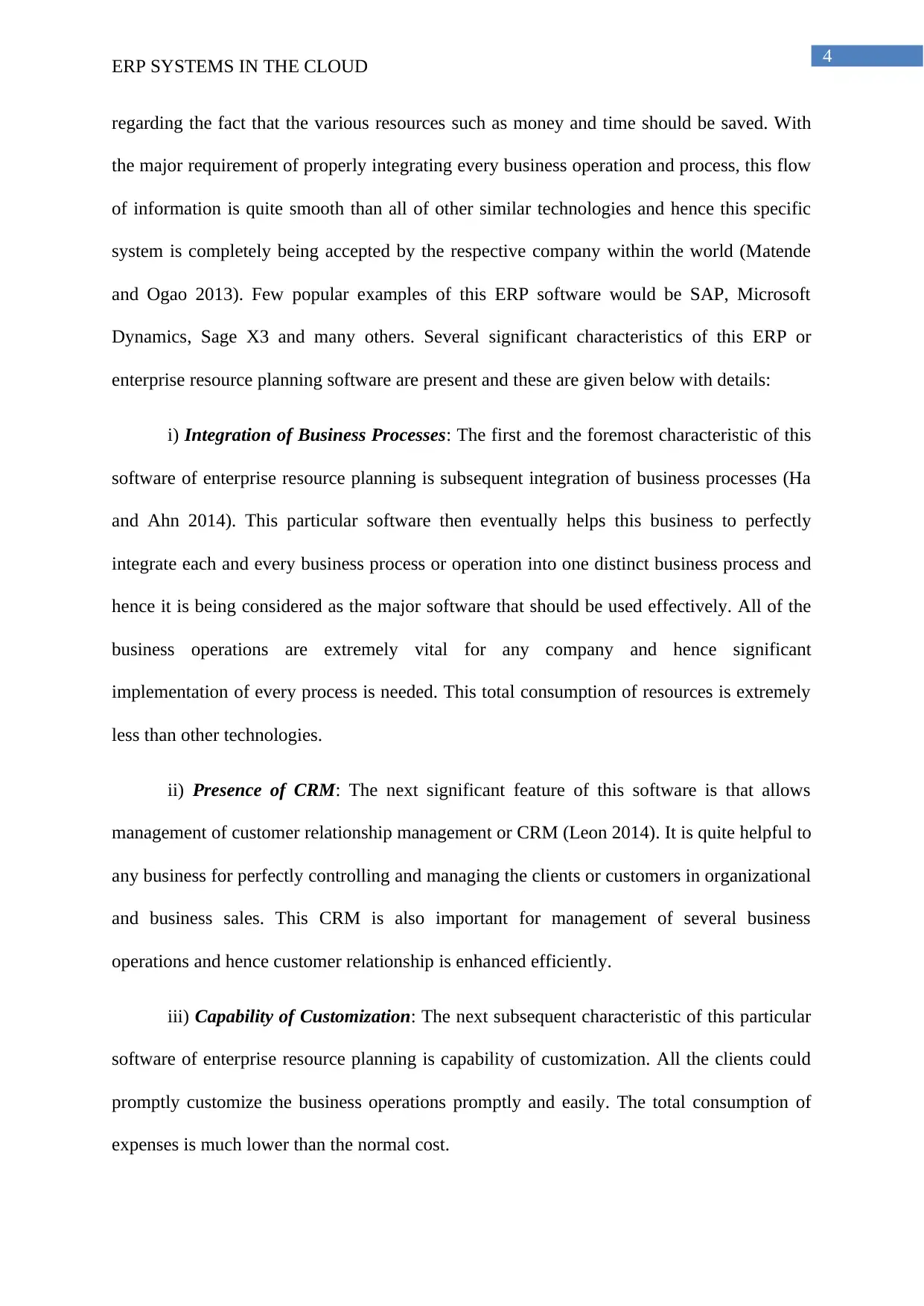
4
ERP SYSTEMS IN THE CLOUD
regarding the fact that the various resources such as money and time should be saved. With
the major requirement of properly integrating every business operation and process, this flow
of information is quite smooth than all of other similar technologies and hence this specific
system is completely being accepted by the respective company within the world (Matende
and Ogao 2013). Few popular examples of this ERP software would be SAP, Microsoft
Dynamics, Sage X3 and many others. Several significant characteristics of this ERP or
enterprise resource planning software are present and these are given below with details:
i) Integration of Business Processes: The first and the foremost characteristic of this
software of enterprise resource planning is subsequent integration of business processes (Ha
and Ahn 2014). This particular software then eventually helps this business to perfectly
integrate each and every business process or operation into one distinct business process and
hence it is being considered as the major software that should be used effectively. All of the
business operations are extremely vital for any company and hence significant
implementation of every process is needed. This total consumption of resources is extremely
less than other technologies.
ii) Presence of CRM: The next significant feature of this software is that allows
management of customer relationship management or CRM (Leon 2014). It is quite helpful to
any business for perfectly controlling and managing the clients or customers in organizational
and business sales. This CRM is also important for management of several business
operations and hence customer relationship is enhanced efficiently.
iii) Capability of Customization: The next subsequent characteristic of this particular
software of enterprise resource planning is capability of customization. All the clients could
promptly customize the business operations promptly and easily. The total consumption of
expenses is much lower than the normal cost.
ERP SYSTEMS IN THE CLOUD
regarding the fact that the various resources such as money and time should be saved. With
the major requirement of properly integrating every business operation and process, this flow
of information is quite smooth than all of other similar technologies and hence this specific
system is completely being accepted by the respective company within the world (Matende
and Ogao 2013). Few popular examples of this ERP software would be SAP, Microsoft
Dynamics, Sage X3 and many others. Several significant characteristics of this ERP or
enterprise resource planning software are present and these are given below with details:
i) Integration of Business Processes: The first and the foremost characteristic of this
software of enterprise resource planning is subsequent integration of business processes (Ha
and Ahn 2014). This particular software then eventually helps this business to perfectly
integrate each and every business process or operation into one distinct business process and
hence it is being considered as the major software that should be used effectively. All of the
business operations are extremely vital for any company and hence significant
implementation of every process is needed. This total consumption of resources is extremely
less than other technologies.
ii) Presence of CRM: The next significant feature of this software is that allows
management of customer relationship management or CRM (Leon 2014). It is quite helpful to
any business for perfectly controlling and managing the clients or customers in organizational
and business sales. This CRM is also important for management of several business
operations and hence customer relationship is enhanced efficiently.
iii) Capability of Customization: The next subsequent characteristic of this particular
software of enterprise resource planning is capability of customization. All the clients could
promptly customize the business operations promptly and easily. The total consumption of
expenses is much lower than the normal cost.
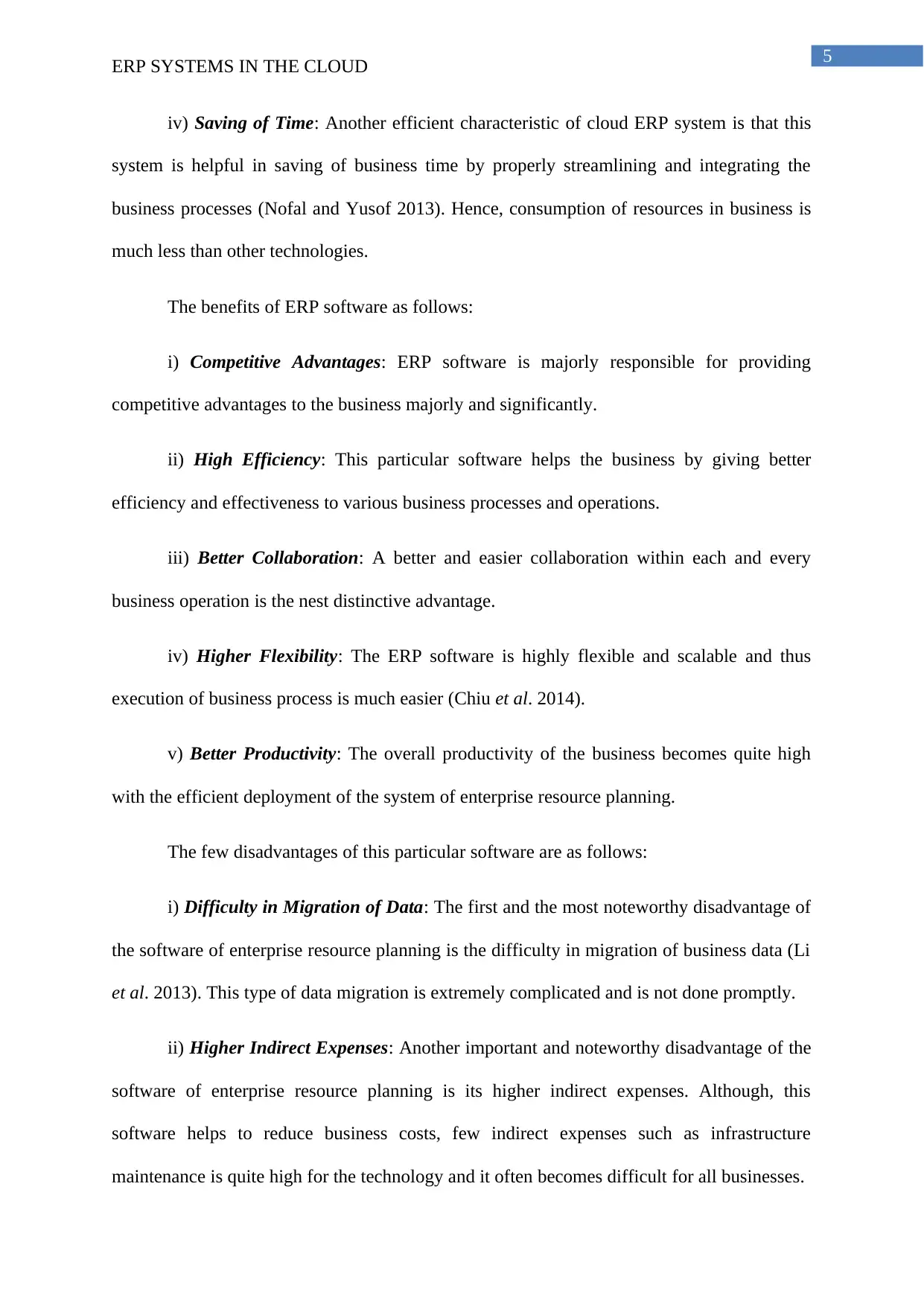
5
ERP SYSTEMS IN THE CLOUD
iv) Saving of Time: Another efficient characteristic of cloud ERP system is that this
system is helpful in saving of business time by properly streamlining and integrating the
business processes (Nofal and Yusof 2013). Hence, consumption of resources in business is
much less than other technologies.
The benefits of ERP software as follows:
i) Competitive Advantages: ERP software is majorly responsible for providing
competitive advantages to the business majorly and significantly.
ii) High Efficiency: This particular software helps the business by giving better
efficiency and effectiveness to various business processes and operations.
iii) Better Collaboration: A better and easier collaboration within each and every
business operation is the nest distinctive advantage.
iv) Higher Flexibility: The ERP software is highly flexible and scalable and thus
execution of business process is much easier (Chiu et al. 2014).
v) Better Productivity: The overall productivity of the business becomes quite high
with the efficient deployment of the system of enterprise resource planning.
The few disadvantages of this particular software are as follows:
i) Difficulty in Migration of Data: The first and the most noteworthy disadvantage of
the software of enterprise resource planning is the difficulty in migration of business data (Li
et al. 2013). This type of data migration is extremely complicated and is not done promptly.
ii) Higher Indirect Expenses: Another important and noteworthy disadvantage of the
software of enterprise resource planning is its higher indirect expenses. Although, this
software helps to reduce business costs, few indirect expenses such as infrastructure
maintenance is quite high for the technology and it often becomes difficult for all businesses.
ERP SYSTEMS IN THE CLOUD
iv) Saving of Time: Another efficient characteristic of cloud ERP system is that this
system is helpful in saving of business time by properly streamlining and integrating the
business processes (Nofal and Yusof 2013). Hence, consumption of resources in business is
much less than other technologies.
The benefits of ERP software as follows:
i) Competitive Advantages: ERP software is majorly responsible for providing
competitive advantages to the business majorly and significantly.
ii) High Efficiency: This particular software helps the business by giving better
efficiency and effectiveness to various business processes and operations.
iii) Better Collaboration: A better and easier collaboration within each and every
business operation is the nest distinctive advantage.
iv) Higher Flexibility: The ERP software is highly flexible and scalable and thus
execution of business process is much easier (Chiu et al. 2014).
v) Better Productivity: The overall productivity of the business becomes quite high
with the efficient deployment of the system of enterprise resource planning.
The few disadvantages of this particular software are as follows:
i) Difficulty in Migration of Data: The first and the most noteworthy disadvantage of
the software of enterprise resource planning is the difficulty in migration of business data (Li
et al. 2013). This type of data migration is extremely complicated and is not done promptly.
ii) Higher Indirect Expenses: Another important and noteworthy disadvantage of the
software of enterprise resource planning is its higher indirect expenses. Although, this
software helps to reduce business costs, few indirect expenses such as infrastructure
maintenance is quite high for the technology and it often becomes difficult for all businesses.

6
ERP SYSTEMS IN THE CLOUD
iii) Lacking of Privacy and Security: The third important or vital disadvantage of the
enterprise resource planning software is the lacking of security as well as privacy (Chang et
al. 2015). It is absolutely dependent on business vendors and hence often there is a loss of
data authenticity and security.
Characteristics, Advantages and Disadvantages of Cloud Computing Technology
The technology of cloud computing is completely dependent on the better sharing of
resources to perfectly achieve economy scale (Hashizume et al. 2013). This specific cloud
computing technology is absolutely helpful to the users for easier and prompt transferring of
data or information through the help of Internet service after not getting involved within any
specified complexity type. As this particular cloud computing technology does not consist of
any complexity, it is quite famous or popular for all users or companies in the world. Four
distinctive models of deployment and three models of architecture are present in cloud
computing technology. These three specified models for cloud computing architecture would
be infrastructure as a service or IaaS, platform as a service or PaaS and finally software as a
service or PaaS. On the other hand, the four specified cloud-deployment models are public
cloud, community cloud, private cloud and lastly hybrid cloud (Dinh et al. 2013). The major
important and significant aspects of this technology of the cloud computing are as follows:
i) Resource Pooling as well as Elasticities: This is the first and the most important
feature of this technology, cloud computing. It eventually enables pooling of resources and
elasticity; hence bringing multi tenancy feature.
ii) Service Quality: The second important and noteworthy characteristic of the cloud
computing technology is that the overall quality of services are extremely improvised in
respect to the cloud computing technology (Rittinghouse and Ransome 2016).
ERP SYSTEMS IN THE CLOUD
iii) Lacking of Privacy and Security: The third important or vital disadvantage of the
enterprise resource planning software is the lacking of security as well as privacy (Chang et
al. 2015). It is absolutely dependent on business vendors and hence often there is a loss of
data authenticity and security.
Characteristics, Advantages and Disadvantages of Cloud Computing Technology
The technology of cloud computing is completely dependent on the better sharing of
resources to perfectly achieve economy scale (Hashizume et al. 2013). This specific cloud
computing technology is absolutely helpful to the users for easier and prompt transferring of
data or information through the help of Internet service after not getting involved within any
specified complexity type. As this particular cloud computing technology does not consist of
any complexity, it is quite famous or popular for all users or companies in the world. Four
distinctive models of deployment and three models of architecture are present in cloud
computing technology. These three specified models for cloud computing architecture would
be infrastructure as a service or IaaS, platform as a service or PaaS and finally software as a
service or PaaS. On the other hand, the four specified cloud-deployment models are public
cloud, community cloud, private cloud and lastly hybrid cloud (Dinh et al. 2013). The major
important and significant aspects of this technology of the cloud computing are as follows:
i) Resource Pooling as well as Elasticities: This is the first and the most important
feature of this technology, cloud computing. It eventually enables pooling of resources and
elasticity; hence bringing multi tenancy feature.
ii) Service Quality: The second important and noteworthy characteristic of the cloud
computing technology is that the overall quality of services are extremely improvised in
respect to the cloud computing technology (Rittinghouse and Ransome 2016).
Paraphrase This Document
Need a fresh take? Get an instant paraphrase of this document with our AI Paraphraser
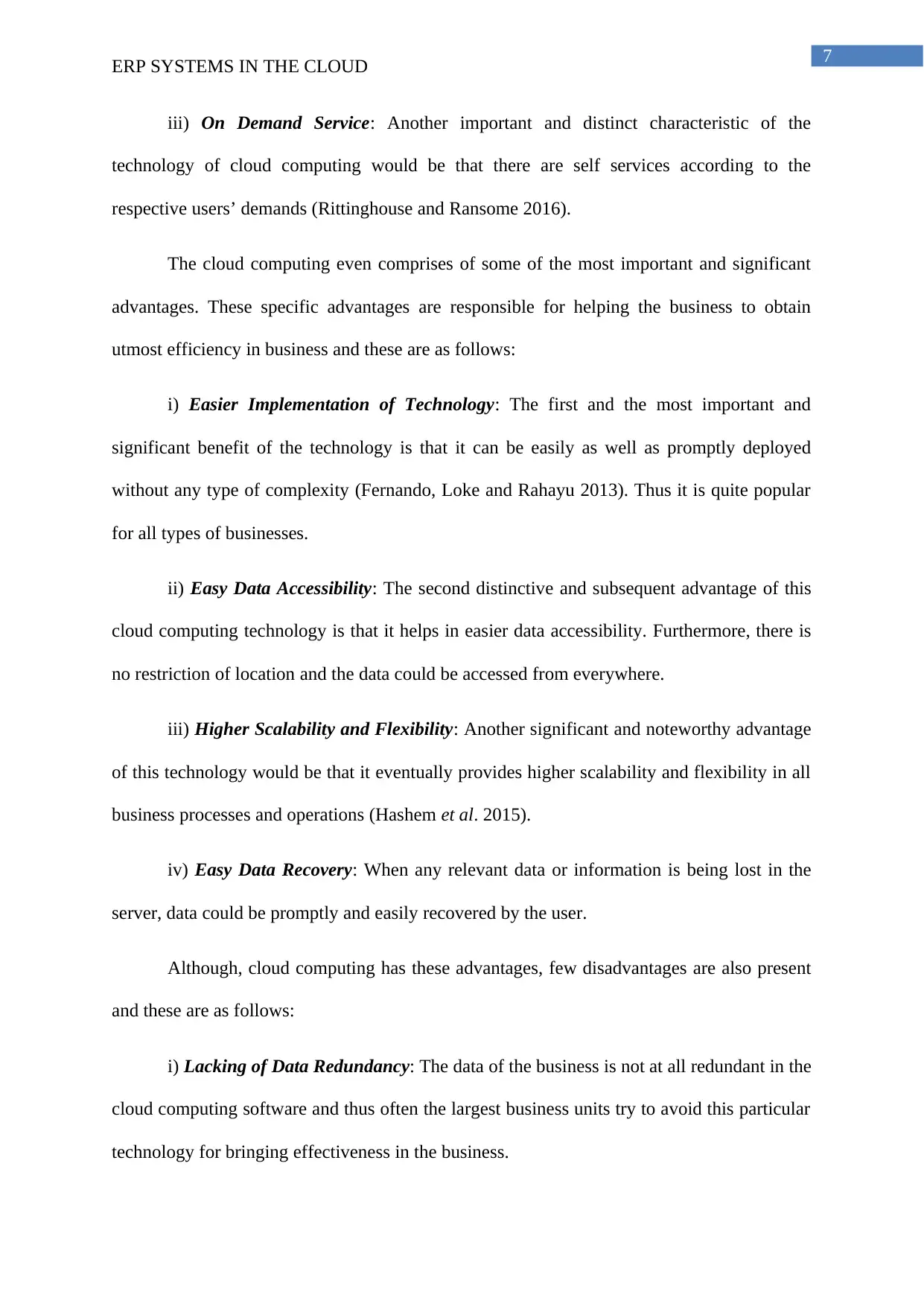
7
ERP SYSTEMS IN THE CLOUD
iii) On Demand Service: Another important and distinct characteristic of the
technology of cloud computing would be that there are self services according to the
respective users’ demands (Rittinghouse and Ransome 2016).
The cloud computing even comprises of some of the most important and significant
advantages. These specific advantages are responsible for helping the business to obtain
utmost efficiency in business and these are as follows:
i) Easier Implementation of Technology: The first and the most important and
significant benefit of the technology is that it can be easily as well as promptly deployed
without any type of complexity (Fernando, Loke and Rahayu 2013). Thus it is quite popular
for all types of businesses.
ii) Easy Data Accessibility: The second distinctive and subsequent advantage of this
cloud computing technology is that it helps in easier data accessibility. Furthermore, there is
no restriction of location and the data could be accessed from everywhere.
iii) Higher Scalability and Flexibility: Another significant and noteworthy advantage
of this technology would be that it eventually provides higher scalability and flexibility in all
business processes and operations (Hashem et al. 2015).
iv) Easy Data Recovery: When any relevant data or information is being lost in the
server, data could be promptly and easily recovered by the user.
Although, cloud computing has these advantages, few disadvantages are also present
and these are as follows:
i) Lacking of Data Redundancy: The data of the business is not at all redundant in the
cloud computing software and thus often the largest business units try to avoid this particular
technology for bringing effectiveness in the business.
ERP SYSTEMS IN THE CLOUD
iii) On Demand Service: Another important and distinct characteristic of the
technology of cloud computing would be that there are self services according to the
respective users’ demands (Rittinghouse and Ransome 2016).
The cloud computing even comprises of some of the most important and significant
advantages. These specific advantages are responsible for helping the business to obtain
utmost efficiency in business and these are as follows:
i) Easier Implementation of Technology: The first and the most important and
significant benefit of the technology is that it can be easily as well as promptly deployed
without any type of complexity (Fernando, Loke and Rahayu 2013). Thus it is quite popular
for all types of businesses.
ii) Easy Data Accessibility: The second distinctive and subsequent advantage of this
cloud computing technology is that it helps in easier data accessibility. Furthermore, there is
no restriction of location and the data could be accessed from everywhere.
iii) Higher Scalability and Flexibility: Another significant and noteworthy advantage
of this technology would be that it eventually provides higher scalability and flexibility in all
business processes and operations (Hashem et al. 2015).
iv) Easy Data Recovery: When any relevant data or information is being lost in the
server, data could be promptly and easily recovered by the user.
Although, cloud computing has these advantages, few disadvantages are also present
and these are as follows:
i) Lacking of Data Redundancy: The data of the business is not at all redundant in the
cloud computing software and thus often the largest business units try to avoid this particular
technology for bringing effectiveness in the business.
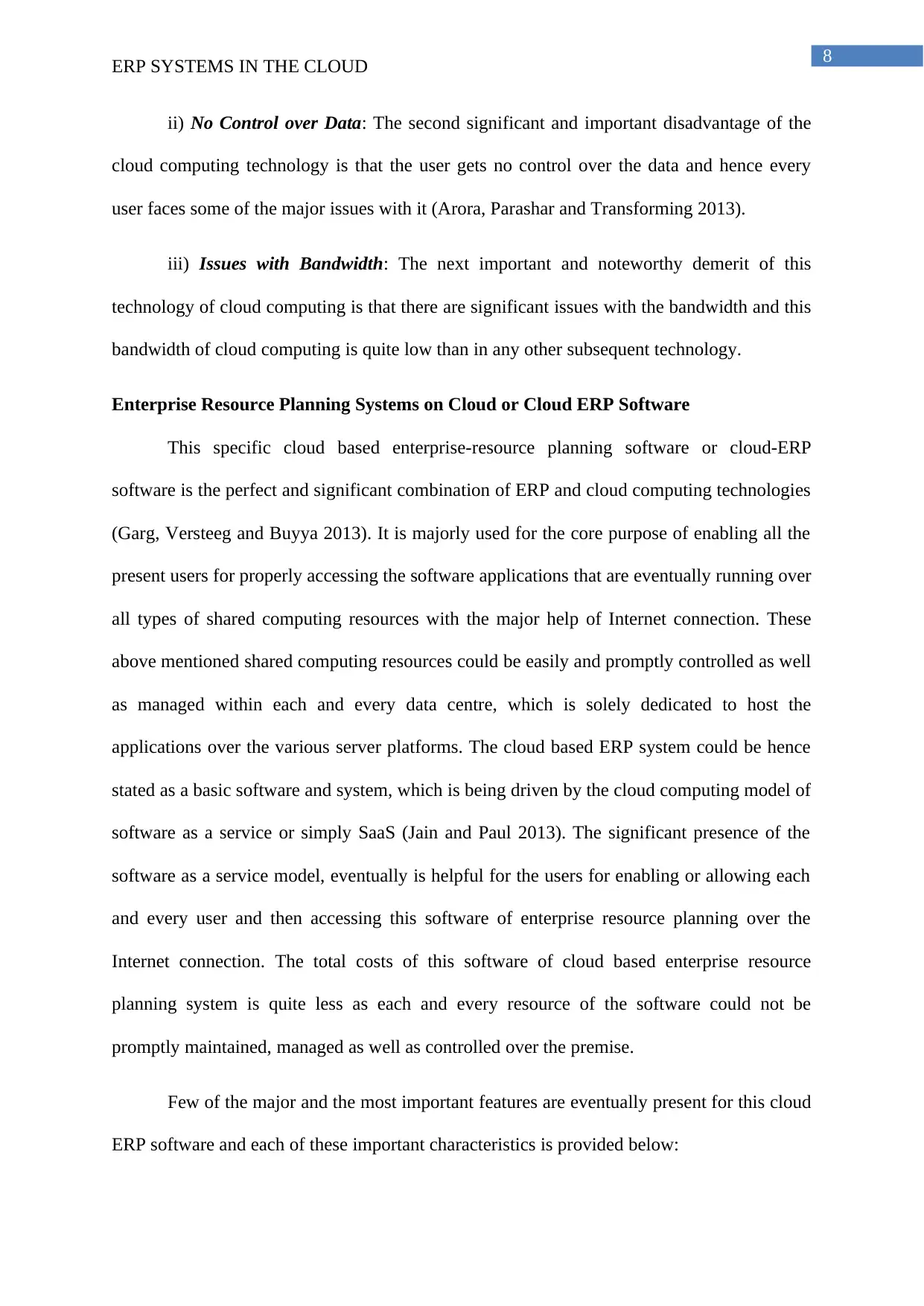
8
ERP SYSTEMS IN THE CLOUD
ii) No Control over Data: The second significant and important disadvantage of the
cloud computing technology is that the user gets no control over the data and hence every
user faces some of the major issues with it (Arora, Parashar and Transforming 2013).
iii) Issues with Bandwidth: The next important and noteworthy demerit of this
technology of cloud computing is that there are significant issues with the bandwidth and this
bandwidth of cloud computing is quite low than in any other subsequent technology.
Enterprise Resource Planning Systems on Cloud or Cloud ERP Software
This specific cloud based enterprise-resource planning software or cloud-ERP
software is the perfect and significant combination of ERP and cloud computing technologies
(Garg, Versteeg and Buyya 2013). It is majorly used for the core purpose of enabling all the
present users for properly accessing the software applications that are eventually running over
all types of shared computing resources with the major help of Internet connection. These
above mentioned shared computing resources could be easily and promptly controlled as well
as managed within each and every data centre, which is solely dedicated to host the
applications over the various server platforms. The cloud based ERP system could be hence
stated as a basic software and system, which is being driven by the cloud computing model of
software as a service or simply SaaS (Jain and Paul 2013). The significant presence of the
software as a service model, eventually is helpful for the users for enabling or allowing each
and every user and then accessing this software of enterprise resource planning over the
Internet connection. The total costs of this software of cloud based enterprise resource
planning system is quite less as each and every resource of the software could not be
promptly maintained, managed as well as controlled over the premise.
Few of the major and the most important features are eventually present for this cloud
ERP software and each of these important characteristics is provided below:
ERP SYSTEMS IN THE CLOUD
ii) No Control over Data: The second significant and important disadvantage of the
cloud computing technology is that the user gets no control over the data and hence every
user faces some of the major issues with it (Arora, Parashar and Transforming 2013).
iii) Issues with Bandwidth: The next important and noteworthy demerit of this
technology of cloud computing is that there are significant issues with the bandwidth and this
bandwidth of cloud computing is quite low than in any other subsequent technology.
Enterprise Resource Planning Systems on Cloud or Cloud ERP Software
This specific cloud based enterprise-resource planning software or cloud-ERP
software is the perfect and significant combination of ERP and cloud computing technologies
(Garg, Versteeg and Buyya 2013). It is majorly used for the core purpose of enabling all the
present users for properly accessing the software applications that are eventually running over
all types of shared computing resources with the major help of Internet connection. These
above mentioned shared computing resources could be easily and promptly controlled as well
as managed within each and every data centre, which is solely dedicated to host the
applications over the various server platforms. The cloud based ERP system could be hence
stated as a basic software and system, which is being driven by the cloud computing model of
software as a service or simply SaaS (Jain and Paul 2013). The significant presence of the
software as a service model, eventually is helpful for the users for enabling or allowing each
and every user and then accessing this software of enterprise resource planning over the
Internet connection. The total costs of this software of cloud based enterprise resource
planning system is quite less as each and every resource of the software could not be
promptly maintained, managed as well as controlled over the premise.
Few of the major and the most important features are eventually present for this cloud
ERP software and each of these important characteristics is provided below:
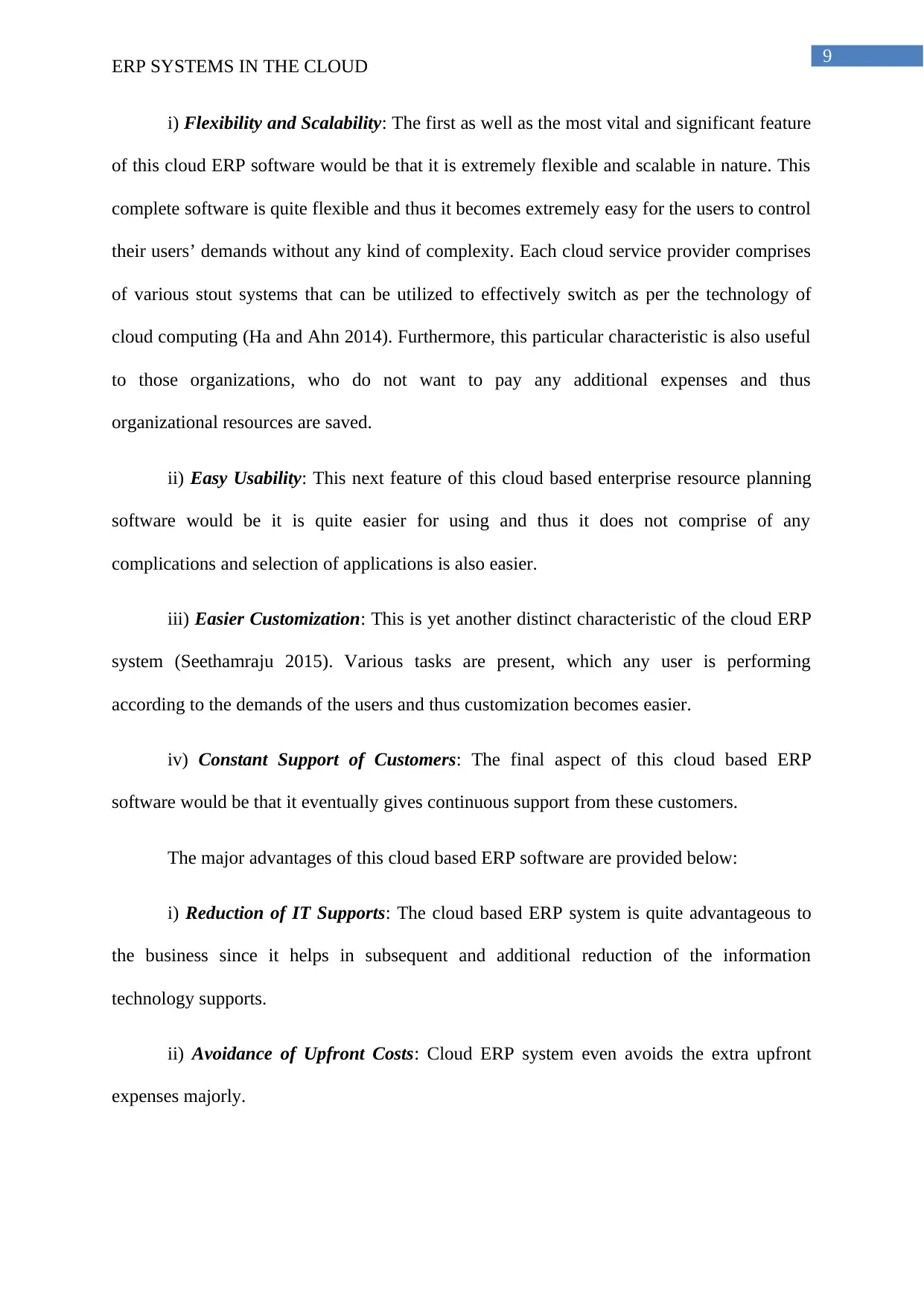
9
ERP SYSTEMS IN THE CLOUD
i) Flexibility and Scalability: The first as well as the most vital and significant feature
of this cloud ERP software would be that it is extremely flexible and scalable in nature. This
complete software is quite flexible and thus it becomes extremely easy for the users to control
their users’ demands without any kind of complexity. Each cloud service provider comprises
of various stout systems that can be utilized to effectively switch as per the technology of
cloud computing (Ha and Ahn 2014). Furthermore, this particular characteristic is also useful
to those organizations, who do not want to pay any additional expenses and thus
organizational resources are saved.
ii) Easy Usability: This next feature of this cloud based enterprise resource planning
software would be it is quite easier for using and thus it does not comprise of any
complications and selection of applications is also easier.
iii) Easier Customization: This is yet another distinct characteristic of the cloud ERP
system (Seethamraju 2015). Various tasks are present, which any user is performing
according to the demands of the users and thus customization becomes easier.
iv) Constant Support of Customers: The final aspect of this cloud based ERP
software would be that it eventually gives continuous support from these customers.
The major advantages of this cloud based ERP software are provided below:
i) Reduction of IT Supports: The cloud based ERP system is quite advantageous to
the business since it helps in subsequent and additional reduction of the information
technology supports.
ii) Avoidance of Upfront Costs: Cloud ERP system even avoids the extra upfront
expenses majorly.
ERP SYSTEMS IN THE CLOUD
i) Flexibility and Scalability: The first as well as the most vital and significant feature
of this cloud ERP software would be that it is extremely flexible and scalable in nature. This
complete software is quite flexible and thus it becomes extremely easy for the users to control
their users’ demands without any kind of complexity. Each cloud service provider comprises
of various stout systems that can be utilized to effectively switch as per the technology of
cloud computing (Ha and Ahn 2014). Furthermore, this particular characteristic is also useful
to those organizations, who do not want to pay any additional expenses and thus
organizational resources are saved.
ii) Easy Usability: This next feature of this cloud based enterprise resource planning
software would be it is quite easier for using and thus it does not comprise of any
complications and selection of applications is also easier.
iii) Easier Customization: This is yet another distinct characteristic of the cloud ERP
system (Seethamraju 2015). Various tasks are present, which any user is performing
according to the demands of the users and thus customization becomes easier.
iv) Constant Support of Customers: The final aspect of this cloud based ERP
software would be that it eventually gives continuous support from these customers.
The major advantages of this cloud based ERP software are provided below:
i) Reduction of IT Supports: The cloud based ERP system is quite advantageous to
the business since it helps in subsequent and additional reduction of the information
technology supports.
ii) Avoidance of Upfront Costs: Cloud ERP system even avoids the extra upfront
expenses majorly.
Secure Best Marks with AI Grader
Need help grading? Try our AI Grader for instant feedback on your assignments.
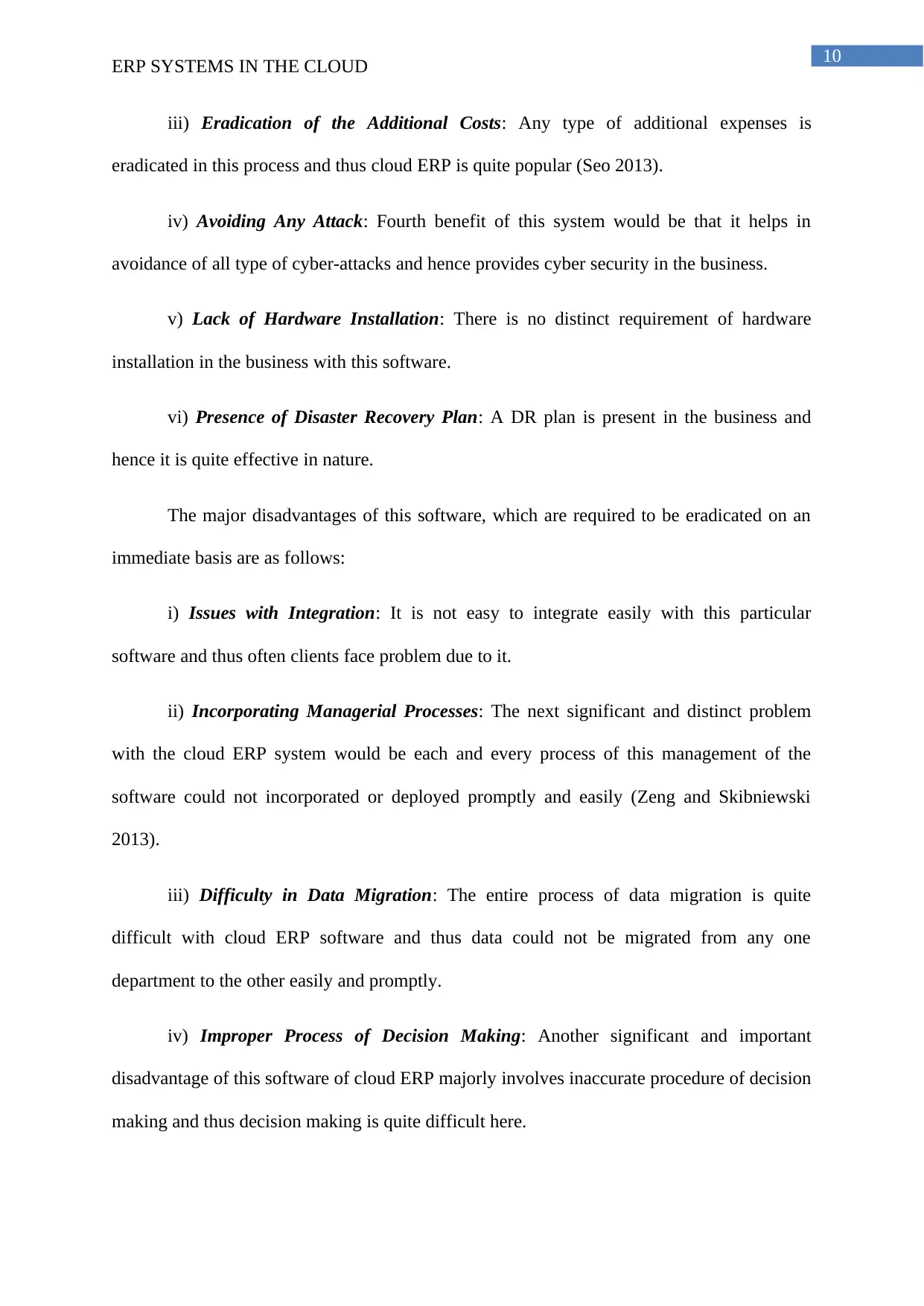
10
ERP SYSTEMS IN THE CLOUD
iii) Eradication of the Additional Costs: Any type of additional expenses is
eradicated in this process and thus cloud ERP is quite popular (Seo 2013).
iv) Avoiding Any Attack: Fourth benefit of this system would be that it helps in
avoidance of all type of cyber-attacks and hence provides cyber security in the business.
v) Lack of Hardware Installation: There is no distinct requirement of hardware
installation in the business with this software.
vi) Presence of Disaster Recovery Plan: A DR plan is present in the business and
hence it is quite effective in nature.
The major disadvantages of this software, which are required to be eradicated on an
immediate basis are as follows:
i) Issues with Integration: It is not easy to integrate easily with this particular
software and thus often clients face problem due to it.
ii) Incorporating Managerial Processes: The next significant and distinct problem
with the cloud ERP system would be each and every process of this management of the
software could not incorporated or deployed promptly and easily (Zeng and Skibniewski
2013).
iii) Difficulty in Data Migration: The entire process of data migration is quite
difficult with cloud ERP software and thus data could not be migrated from any one
department to the other easily and promptly.
iv) Improper Process of Decision Making: Another significant and important
disadvantage of this software of cloud ERP majorly involves inaccurate procedure of decision
making and thus decision making is quite difficult here.
ERP SYSTEMS IN THE CLOUD
iii) Eradication of the Additional Costs: Any type of additional expenses is
eradicated in this process and thus cloud ERP is quite popular (Seo 2013).
iv) Avoiding Any Attack: Fourth benefit of this system would be that it helps in
avoidance of all type of cyber-attacks and hence provides cyber security in the business.
v) Lack of Hardware Installation: There is no distinct requirement of hardware
installation in the business with this software.
vi) Presence of Disaster Recovery Plan: A DR plan is present in the business and
hence it is quite effective in nature.
The major disadvantages of this software, which are required to be eradicated on an
immediate basis are as follows:
i) Issues with Integration: It is not easy to integrate easily with this particular
software and thus often clients face problem due to it.
ii) Incorporating Managerial Processes: The next significant and distinct problem
with the cloud ERP system would be each and every process of this management of the
software could not incorporated or deployed promptly and easily (Zeng and Skibniewski
2013).
iii) Difficulty in Data Migration: The entire process of data migration is quite
difficult with cloud ERP software and thus data could not be migrated from any one
department to the other easily and promptly.
iv) Improper Process of Decision Making: Another significant and important
disadvantage of this software of cloud ERP majorly involves inaccurate procedure of decision
making and thus decision making is quite difficult here.
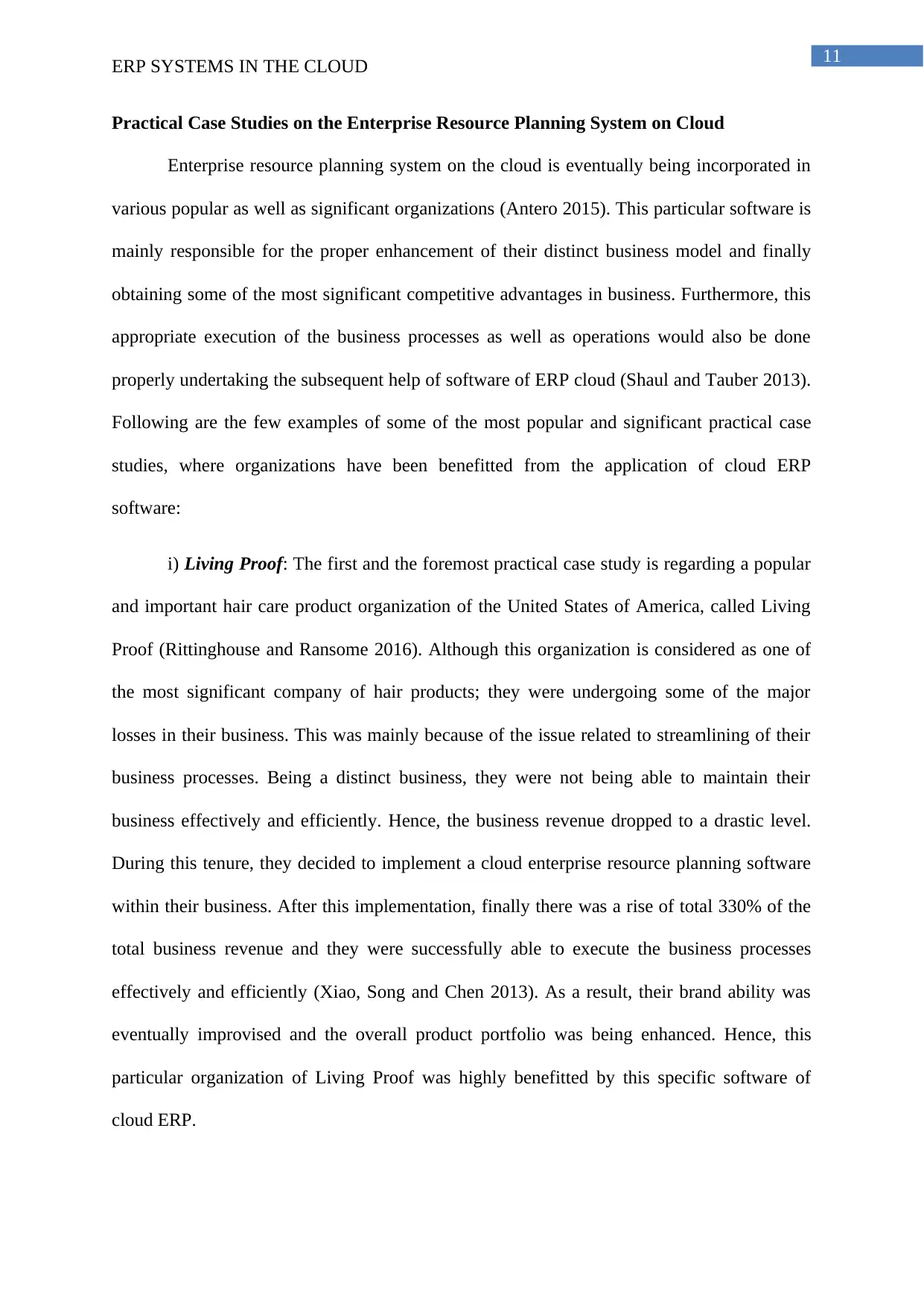
11
ERP SYSTEMS IN THE CLOUD
Practical Case Studies on the Enterprise Resource Planning System on Cloud
Enterprise resource planning system on the cloud is eventually being incorporated in
various popular as well as significant organizations (Antero 2015). This particular software is
mainly responsible for the proper enhancement of their distinct business model and finally
obtaining some of the most significant competitive advantages in business. Furthermore, this
appropriate execution of the business processes as well as operations would also be done
properly undertaking the subsequent help of software of ERP cloud (Shaul and Tauber 2013).
Following are the few examples of some of the most popular and significant practical case
studies, where organizations have been benefitted from the application of cloud ERP
software:
i) Living Proof: The first and the foremost practical case study is regarding a popular
and important hair care product organization of the United States of America, called Living
Proof (Rittinghouse and Ransome 2016). Although this organization is considered as one of
the most significant company of hair products; they were undergoing some of the major
losses in their business. This was mainly because of the issue related to streamlining of their
business processes. Being a distinct business, they were not being able to maintain their
business effectively and efficiently. Hence, the business revenue dropped to a drastic level.
During this tenure, they decided to implement a cloud enterprise resource planning software
within their business. After this implementation, finally there was a rise of total 330% of the
total business revenue and they were successfully able to execute the business processes
effectively and efficiently (Xiao, Song and Chen 2013). As a result, their brand ability was
eventually improvised and the overall product portfolio was being enhanced. Hence, this
particular organization of Living Proof was highly benefitted by this specific software of
cloud ERP.
ERP SYSTEMS IN THE CLOUD
Practical Case Studies on the Enterprise Resource Planning System on Cloud
Enterprise resource planning system on the cloud is eventually being incorporated in
various popular as well as significant organizations (Antero 2015). This particular software is
mainly responsible for the proper enhancement of their distinct business model and finally
obtaining some of the most significant competitive advantages in business. Furthermore, this
appropriate execution of the business processes as well as operations would also be done
properly undertaking the subsequent help of software of ERP cloud (Shaul and Tauber 2013).
Following are the few examples of some of the most popular and significant practical case
studies, where organizations have been benefitted from the application of cloud ERP
software:
i) Living Proof: The first and the foremost practical case study is regarding a popular
and important hair care product organization of the United States of America, called Living
Proof (Rittinghouse and Ransome 2016). Although this organization is considered as one of
the most significant company of hair products; they were undergoing some of the major
losses in their business. This was mainly because of the issue related to streamlining of their
business processes. Being a distinct business, they were not being able to maintain their
business effectively and efficiently. Hence, the business revenue dropped to a drastic level.
During this tenure, they decided to implement a cloud enterprise resource planning software
within their business. After this implementation, finally there was a rise of total 330% of the
total business revenue and they were successfully able to execute the business processes
effectively and efficiently (Xiao, Song and Chen 2013). As a result, their brand ability was
eventually improvised and the overall product portfolio was being enhanced. Hence, this
particular organization of Living Proof was highly benefitted by this specific software of
cloud ERP.
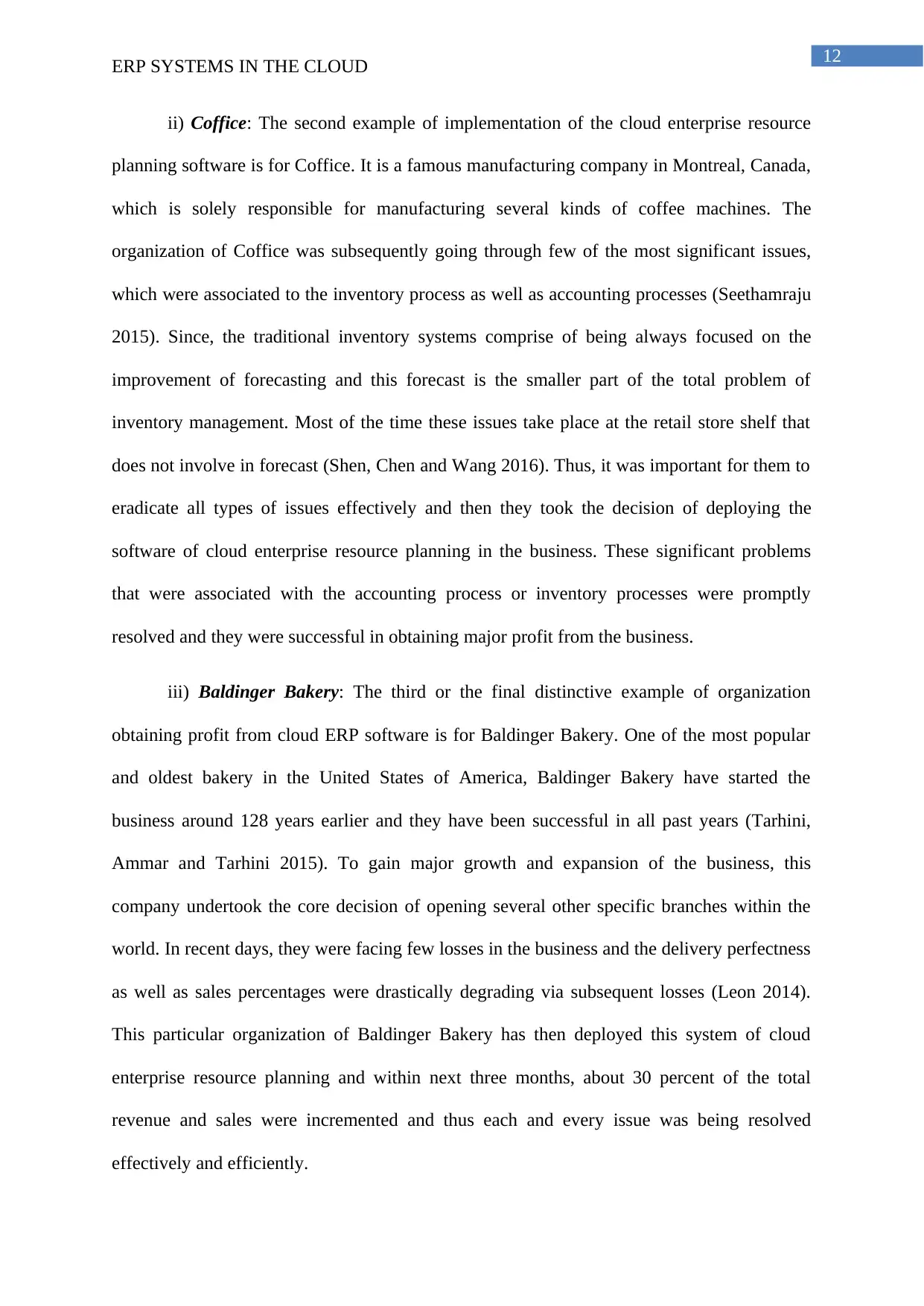
12
ERP SYSTEMS IN THE CLOUD
ii) Coffice: The second example of implementation of the cloud enterprise resource
planning software is for Coffice. It is a famous manufacturing company in Montreal, Canada,
which is solely responsible for manufacturing several kinds of coffee machines. The
organization of Coffice was subsequently going through few of the most significant issues,
which were associated to the inventory process as well as accounting processes (Seethamraju
2015). Since, the traditional inventory systems comprise of being always focused on the
improvement of forecasting and this forecast is the smaller part of the total problem of
inventory management. Most of the time these issues take place at the retail store shelf that
does not involve in forecast (Shen, Chen and Wang 2016). Thus, it was important for them to
eradicate all types of issues effectively and then they took the decision of deploying the
software of cloud enterprise resource planning in the business. These significant problems
that were associated with the accounting process or inventory processes were promptly
resolved and they were successful in obtaining major profit from the business.
iii) Baldinger Bakery: The third or the final distinctive example of organization
obtaining profit from cloud ERP software is for Baldinger Bakery. One of the most popular
and oldest bakery in the United States of America, Baldinger Bakery have started the
business around 128 years earlier and they have been successful in all past years (Tarhini,
Ammar and Tarhini 2015). To gain major growth and expansion of the business, this
company undertook the core decision of opening several other specific branches within the
world. In recent days, they were facing few losses in the business and the delivery perfectness
as well as sales percentages were drastically degrading via subsequent losses (Leon 2014).
This particular organization of Baldinger Bakery has then deployed this system of cloud
enterprise resource planning and within next three months, about 30 percent of the total
revenue and sales were incremented and thus each and every issue was being resolved
effectively and efficiently.
ERP SYSTEMS IN THE CLOUD
ii) Coffice: The second example of implementation of the cloud enterprise resource
planning software is for Coffice. It is a famous manufacturing company in Montreal, Canada,
which is solely responsible for manufacturing several kinds of coffee machines. The
organization of Coffice was subsequently going through few of the most significant issues,
which were associated to the inventory process as well as accounting processes (Seethamraju
2015). Since, the traditional inventory systems comprise of being always focused on the
improvement of forecasting and this forecast is the smaller part of the total problem of
inventory management. Most of the time these issues take place at the retail store shelf that
does not involve in forecast (Shen, Chen and Wang 2016). Thus, it was important for them to
eradicate all types of issues effectively and then they took the decision of deploying the
software of cloud enterprise resource planning in the business. These significant problems
that were associated with the accounting process or inventory processes were promptly
resolved and they were successful in obtaining major profit from the business.
iii) Baldinger Bakery: The third or the final distinctive example of organization
obtaining profit from cloud ERP software is for Baldinger Bakery. One of the most popular
and oldest bakery in the United States of America, Baldinger Bakery have started the
business around 128 years earlier and they have been successful in all past years (Tarhini,
Ammar and Tarhini 2015). To gain major growth and expansion of the business, this
company undertook the core decision of opening several other specific branches within the
world. In recent days, they were facing few losses in the business and the delivery perfectness
as well as sales percentages were drastically degrading via subsequent losses (Leon 2014).
This particular organization of Baldinger Bakery has then deployed this system of cloud
enterprise resource planning and within next three months, about 30 percent of the total
revenue and sales were incremented and thus each and every issue was being resolved
effectively and efficiently.
Paraphrase This Document
Need a fresh take? Get an instant paraphrase of this document with our AI Paraphraser
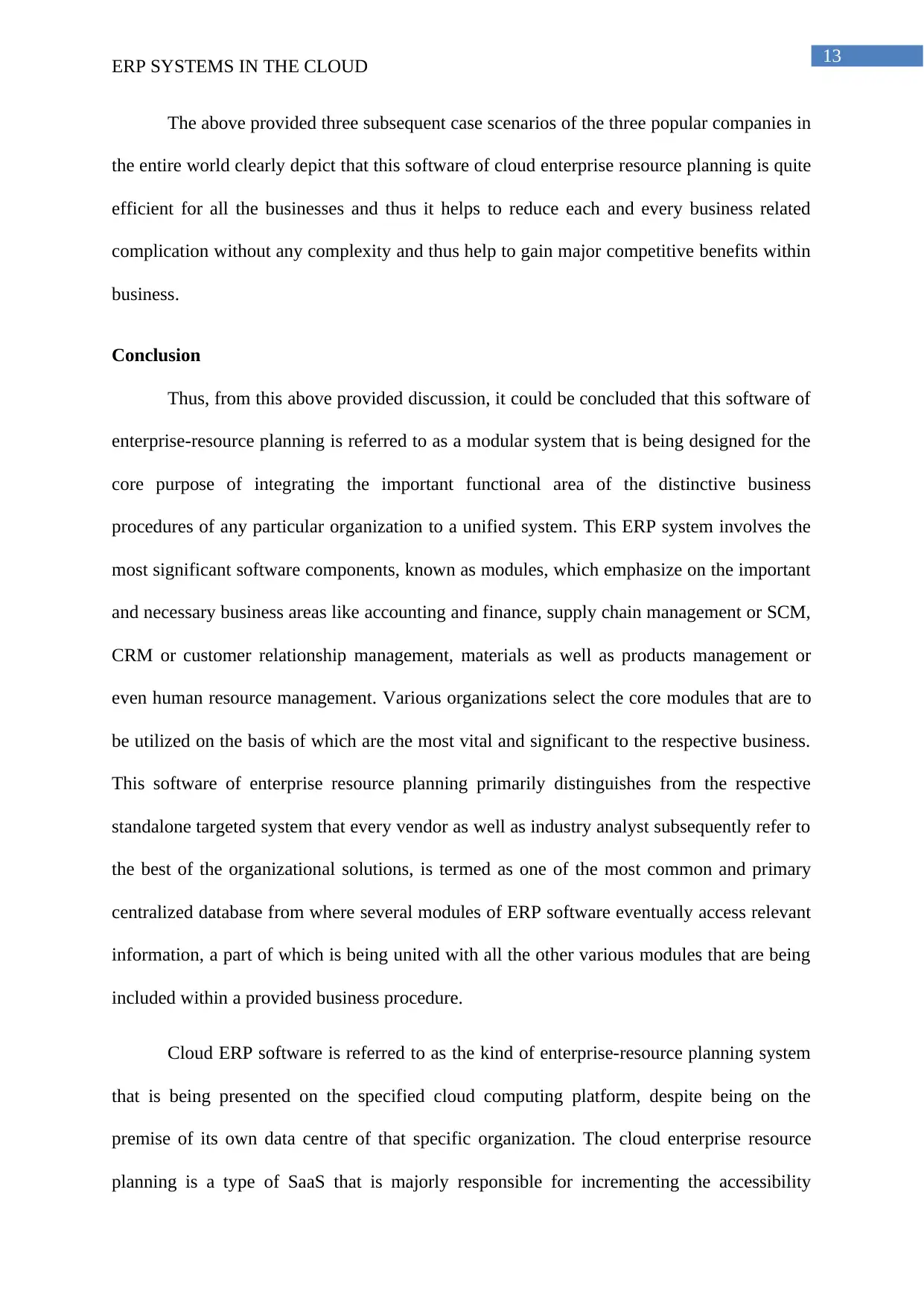
13
ERP SYSTEMS IN THE CLOUD
The above provided three subsequent case scenarios of the three popular companies in
the entire world clearly depict that this software of cloud enterprise resource planning is quite
efficient for all the businesses and thus it helps to reduce each and every business related
complication without any complexity and thus help to gain major competitive benefits within
business.
Conclusion
Thus, from this above provided discussion, it could be concluded that this software of
enterprise-resource planning is referred to as a modular system that is being designed for the
core purpose of integrating the important functional area of the distinctive business
procedures of any particular organization to a unified system. This ERP system involves the
most significant software components, known as modules, which emphasize on the important
and necessary business areas like accounting and finance, supply chain management or SCM,
CRM or customer relationship management, materials as well as products management or
even human resource management. Various organizations select the core modules that are to
be utilized on the basis of which are the most vital and significant to the respective business.
This software of enterprise resource planning primarily distinguishes from the respective
standalone targeted system that every vendor as well as industry analyst subsequently refer to
the best of the organizational solutions, is termed as one of the most common and primary
centralized database from where several modules of ERP software eventually access relevant
information, a part of which is being united with all the other various modules that are being
included within a provided business procedure.
Cloud ERP software is referred to as the kind of enterprise-resource planning system
that is being presented on the specified cloud computing platform, despite being on the
premise of its own data centre of that specific organization. The cloud enterprise resource
planning is a type of SaaS that is majorly responsible for incrementing the accessibility
ERP SYSTEMS IN THE CLOUD
The above provided three subsequent case scenarios of the three popular companies in
the entire world clearly depict that this software of cloud enterprise resource planning is quite
efficient for all the businesses and thus it helps to reduce each and every business related
complication without any complexity and thus help to gain major competitive benefits within
business.
Conclusion
Thus, from this above provided discussion, it could be concluded that this software of
enterprise-resource planning is referred to as a modular system that is being designed for the
core purpose of integrating the important functional area of the distinctive business
procedures of any particular organization to a unified system. This ERP system involves the
most significant software components, known as modules, which emphasize on the important
and necessary business areas like accounting and finance, supply chain management or SCM,
CRM or customer relationship management, materials as well as products management or
even human resource management. Various organizations select the core modules that are to
be utilized on the basis of which are the most vital and significant to the respective business.
This software of enterprise resource planning primarily distinguishes from the respective
standalone targeted system that every vendor as well as industry analyst subsequently refer to
the best of the organizational solutions, is termed as one of the most common and primary
centralized database from where several modules of ERP software eventually access relevant
information, a part of which is being united with all the other various modules that are being
included within a provided business procedure.
Cloud ERP software is referred to as the kind of enterprise-resource planning system
that is being presented on the specified cloud computing platform, despite being on the
premise of its own data centre of that specific organization. The cloud enterprise resource
planning is a type of SaaS that is majorly responsible for incrementing the accessibility
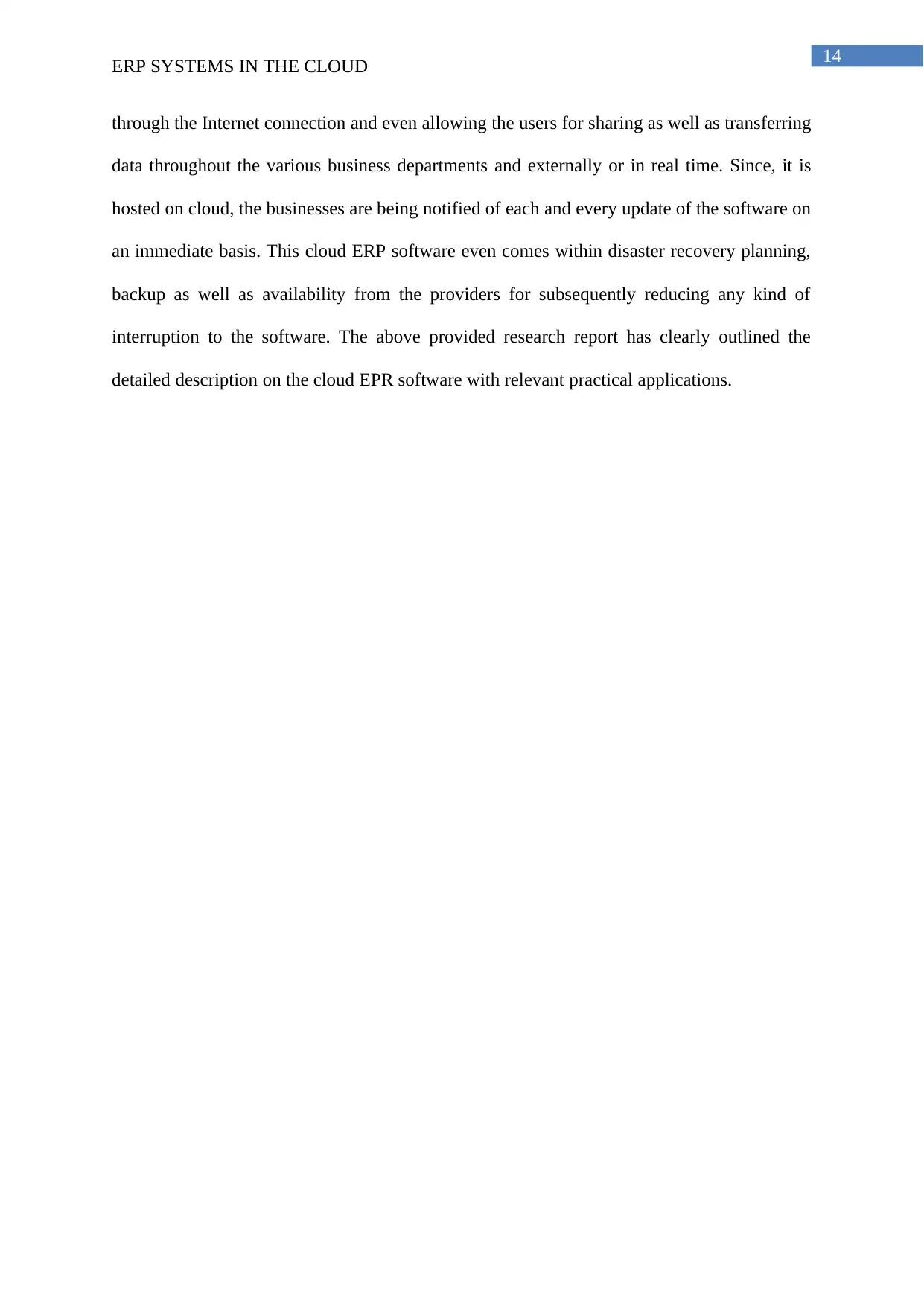
14
ERP SYSTEMS IN THE CLOUD
through the Internet connection and even allowing the users for sharing as well as transferring
data throughout the various business departments and externally or in real time. Since, it is
hosted on cloud, the businesses are being notified of each and every update of the software on
an immediate basis. This cloud ERP software even comes within disaster recovery planning,
backup as well as availability from the providers for subsequently reducing any kind of
interruption to the software. The above provided research report has clearly outlined the
detailed description on the cloud EPR software with relevant practical applications.
ERP SYSTEMS IN THE CLOUD
through the Internet connection and even allowing the users for sharing as well as transferring
data throughout the various business departments and externally or in real time. Since, it is
hosted on cloud, the businesses are being notified of each and every update of the software on
an immediate basis. This cloud ERP software even comes within disaster recovery planning,
backup as well as availability from the providers for subsequently reducing any kind of
interruption to the software. The above provided research report has clearly outlined the
detailed description on the cloud EPR software with relevant practical applications.
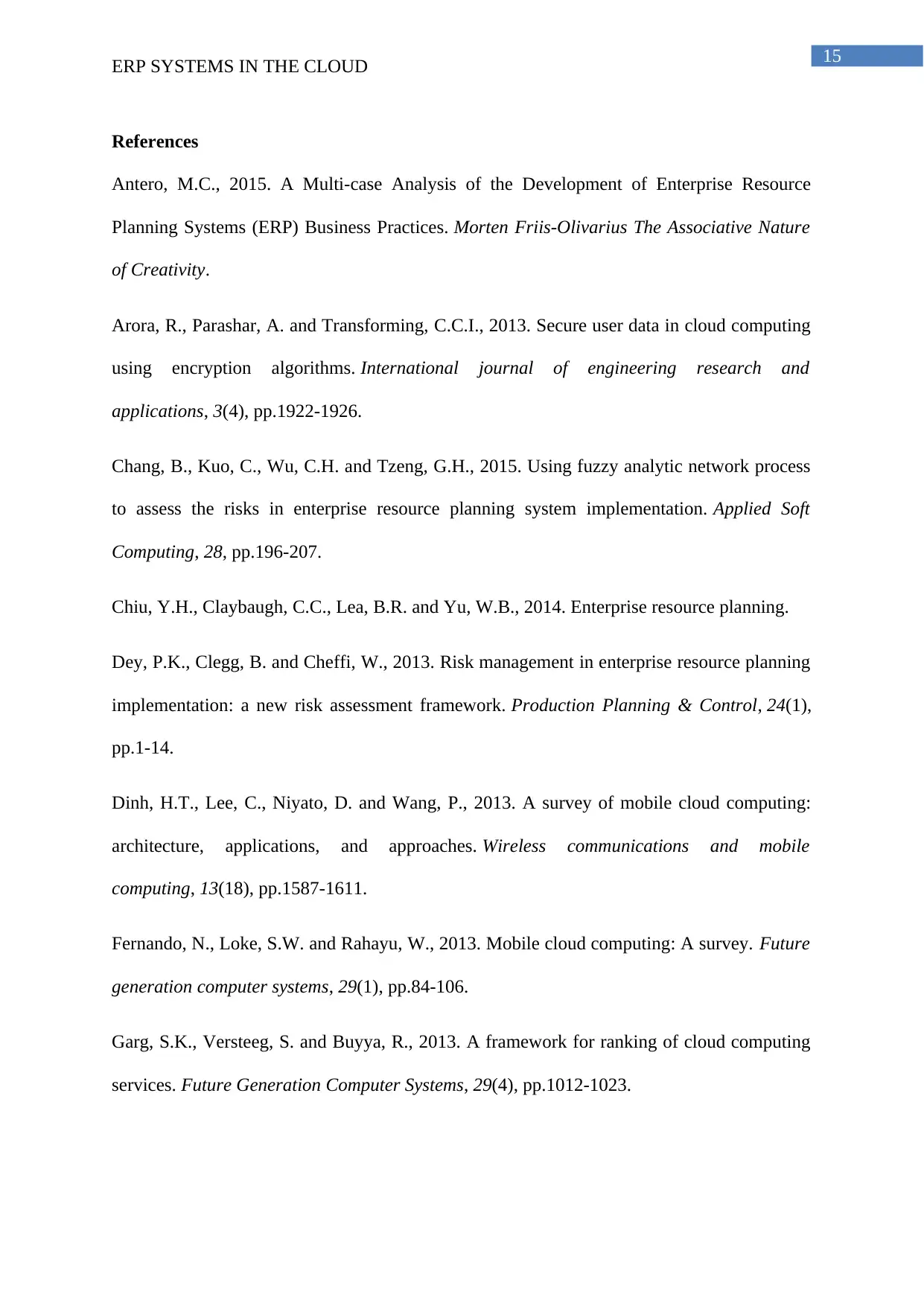
15
ERP SYSTEMS IN THE CLOUD
References
Antero, M.C., 2015. A Multi-case Analysis of the Development of Enterprise Resource
Planning Systems (ERP) Business Practices. Morten Friis-Olivarius The Associative Nature
of Creativity.
Arora, R., Parashar, A. and Transforming, C.C.I., 2013. Secure user data in cloud computing
using encryption algorithms. International journal of engineering research and
applications, 3(4), pp.1922-1926.
Chang, B., Kuo, C., Wu, C.H. and Tzeng, G.H., 2015. Using fuzzy analytic network process
to assess the risks in enterprise resource planning system implementation. Applied Soft
Computing, 28, pp.196-207.
Chiu, Y.H., Claybaugh, C.C., Lea, B.R. and Yu, W.B., 2014. Enterprise resource planning.
Dey, P.K., Clegg, B. and Cheffi, W., 2013. Risk management in enterprise resource planning
implementation: a new risk assessment framework. Production Planning & Control, 24(1),
pp.1-14.
Dinh, H.T., Lee, C., Niyato, D. and Wang, P., 2013. A survey of mobile cloud computing:
architecture, applications, and approaches. Wireless communications and mobile
computing, 13(18), pp.1587-1611.
Fernando, N., Loke, S.W. and Rahayu, W., 2013. Mobile cloud computing: A survey. Future
generation computer systems, 29(1), pp.84-106.
Garg, S.K., Versteeg, S. and Buyya, R., 2013. A framework for ranking of cloud computing
services. Future Generation Computer Systems, 29(4), pp.1012-1023.
ERP SYSTEMS IN THE CLOUD
References
Antero, M.C., 2015. A Multi-case Analysis of the Development of Enterprise Resource
Planning Systems (ERP) Business Practices. Morten Friis-Olivarius The Associative Nature
of Creativity.
Arora, R., Parashar, A. and Transforming, C.C.I., 2013. Secure user data in cloud computing
using encryption algorithms. International journal of engineering research and
applications, 3(4), pp.1922-1926.
Chang, B., Kuo, C., Wu, C.H. and Tzeng, G.H., 2015. Using fuzzy analytic network process
to assess the risks in enterprise resource planning system implementation. Applied Soft
Computing, 28, pp.196-207.
Chiu, Y.H., Claybaugh, C.C., Lea, B.R. and Yu, W.B., 2014. Enterprise resource planning.
Dey, P.K., Clegg, B. and Cheffi, W., 2013. Risk management in enterprise resource planning
implementation: a new risk assessment framework. Production Planning & Control, 24(1),
pp.1-14.
Dinh, H.T., Lee, C., Niyato, D. and Wang, P., 2013. A survey of mobile cloud computing:
architecture, applications, and approaches. Wireless communications and mobile
computing, 13(18), pp.1587-1611.
Fernando, N., Loke, S.W. and Rahayu, W., 2013. Mobile cloud computing: A survey. Future
generation computer systems, 29(1), pp.84-106.
Garg, S.K., Versteeg, S. and Buyya, R., 2013. A framework for ranking of cloud computing
services. Future Generation Computer Systems, 29(4), pp.1012-1023.
Secure Best Marks with AI Grader
Need help grading? Try our AI Grader for instant feedback on your assignments.
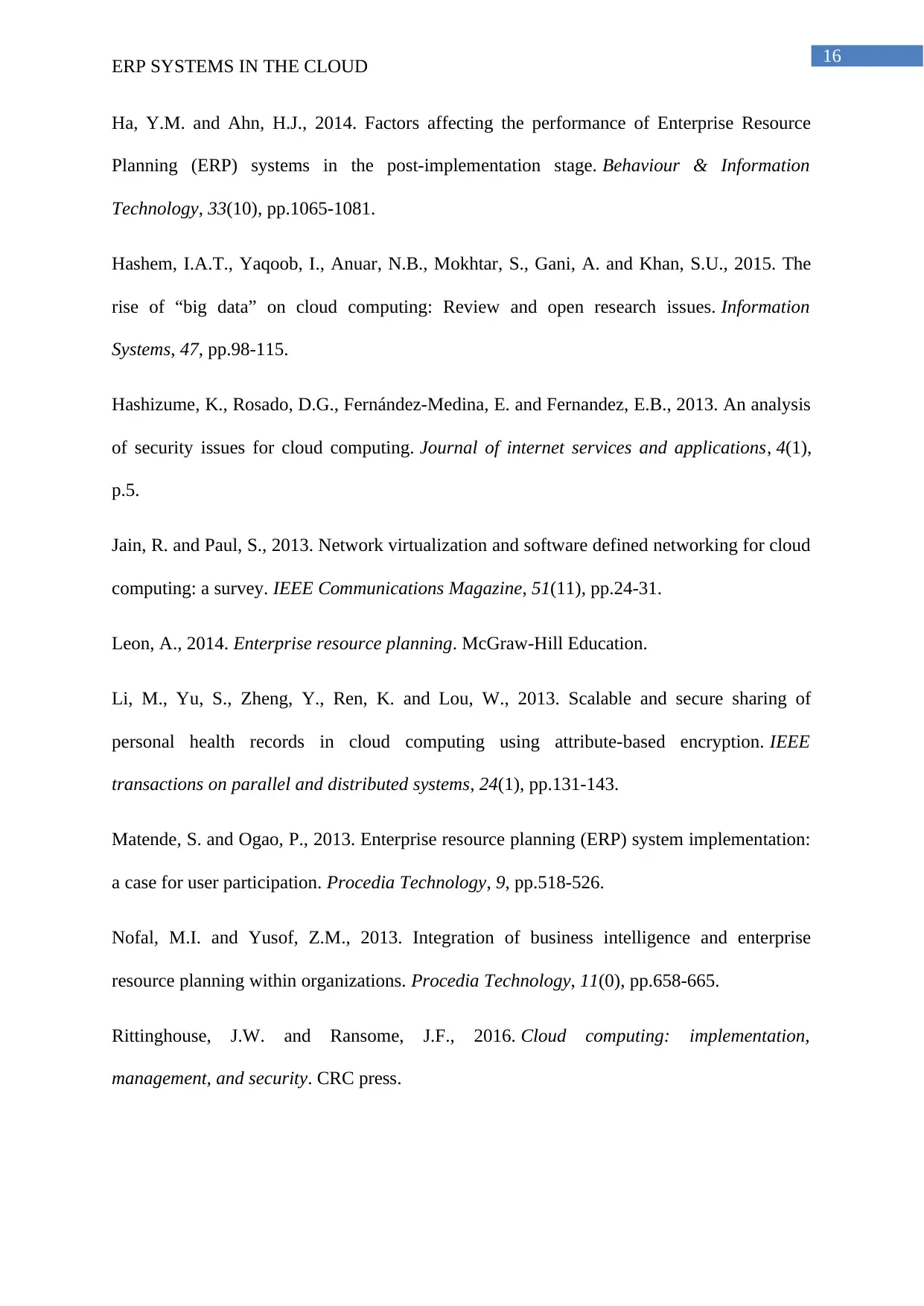
16
ERP SYSTEMS IN THE CLOUD
Ha, Y.M. and Ahn, H.J., 2014. Factors affecting the performance of Enterprise Resource
Planning (ERP) systems in the post-implementation stage. Behaviour & Information
Technology, 33(10), pp.1065-1081.
Hashem, I.A.T., Yaqoob, I., Anuar, N.B., Mokhtar, S., Gani, A. and Khan, S.U., 2015. The
rise of “big data” on cloud computing: Review and open research issues. Information
Systems, 47, pp.98-115.
Hashizume, K., Rosado, D.G., Fernández-Medina, E. and Fernandez, E.B., 2013. An analysis
of security issues for cloud computing. Journal of internet services and applications, 4(1),
p.5.
Jain, R. and Paul, S., 2013. Network virtualization and software defined networking for cloud
computing: a survey. IEEE Communications Magazine, 51(11), pp.24-31.
Leon, A., 2014. Enterprise resource planning. McGraw-Hill Education.
Li, M., Yu, S., Zheng, Y., Ren, K. and Lou, W., 2013. Scalable and secure sharing of
personal health records in cloud computing using attribute-based encryption. IEEE
transactions on parallel and distributed systems, 24(1), pp.131-143.
Matende, S. and Ogao, P., 2013. Enterprise resource planning (ERP) system implementation:
a case for user participation. Procedia Technology, 9, pp.518-526.
Nofal, M.I. and Yusof, Z.M., 2013. Integration of business intelligence and enterprise
resource planning within organizations. Procedia Technology, 11(0), pp.658-665.
Rittinghouse, J.W. and Ransome, J.F., 2016. Cloud computing: implementation,
management, and security. CRC press.
ERP SYSTEMS IN THE CLOUD
Ha, Y.M. and Ahn, H.J., 2014. Factors affecting the performance of Enterprise Resource
Planning (ERP) systems in the post-implementation stage. Behaviour & Information
Technology, 33(10), pp.1065-1081.
Hashem, I.A.T., Yaqoob, I., Anuar, N.B., Mokhtar, S., Gani, A. and Khan, S.U., 2015. The
rise of “big data” on cloud computing: Review and open research issues. Information
Systems, 47, pp.98-115.
Hashizume, K., Rosado, D.G., Fernández-Medina, E. and Fernandez, E.B., 2013. An analysis
of security issues for cloud computing. Journal of internet services and applications, 4(1),
p.5.
Jain, R. and Paul, S., 2013. Network virtualization and software defined networking for cloud
computing: a survey. IEEE Communications Magazine, 51(11), pp.24-31.
Leon, A., 2014. Enterprise resource planning. McGraw-Hill Education.
Li, M., Yu, S., Zheng, Y., Ren, K. and Lou, W., 2013. Scalable and secure sharing of
personal health records in cloud computing using attribute-based encryption. IEEE
transactions on parallel and distributed systems, 24(1), pp.131-143.
Matende, S. and Ogao, P., 2013. Enterprise resource planning (ERP) system implementation:
a case for user participation. Procedia Technology, 9, pp.518-526.
Nofal, M.I. and Yusof, Z.M., 2013. Integration of business intelligence and enterprise
resource planning within organizations. Procedia Technology, 11(0), pp.658-665.
Rittinghouse, J.W. and Ransome, J.F., 2016. Cloud computing: implementation,
management, and security. CRC press.
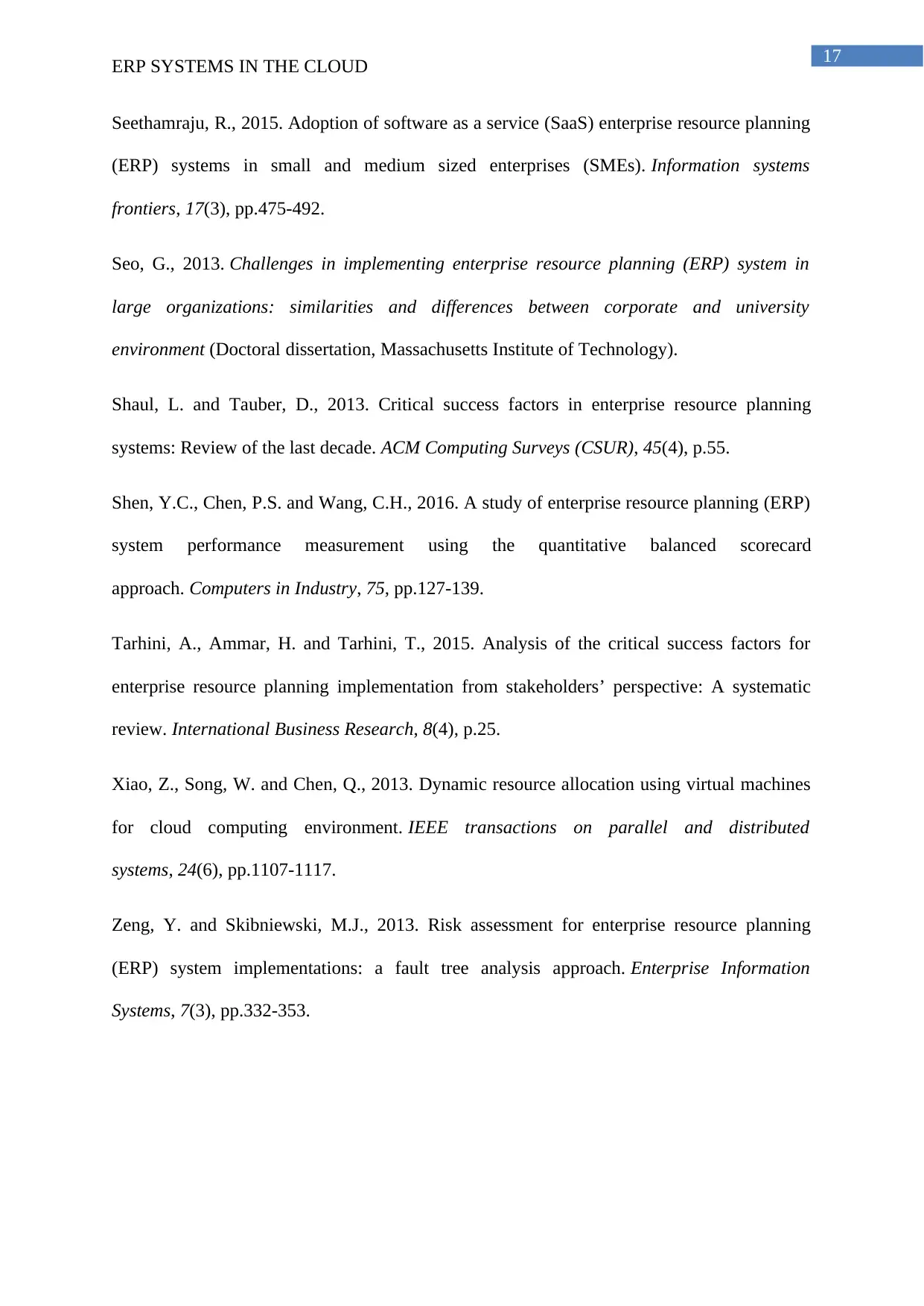
17
ERP SYSTEMS IN THE CLOUD
Seethamraju, R., 2015. Adoption of software as a service (SaaS) enterprise resource planning
(ERP) systems in small and medium sized enterprises (SMEs). Information systems
frontiers, 17(3), pp.475-492.
Seo, G., 2013. Challenges in implementing enterprise resource planning (ERP) system in
large organizations: similarities and differences between corporate and university
environment (Doctoral dissertation, Massachusetts Institute of Technology).
Shaul, L. and Tauber, D., 2013. Critical success factors in enterprise resource planning
systems: Review of the last decade. ACM Computing Surveys (CSUR), 45(4), p.55.
Shen, Y.C., Chen, P.S. and Wang, C.H., 2016. A study of enterprise resource planning (ERP)
system performance measurement using the quantitative balanced scorecard
approach. Computers in Industry, 75, pp.127-139.
Tarhini, A., Ammar, H. and Tarhini, T., 2015. Analysis of the critical success factors for
enterprise resource planning implementation from stakeholders’ perspective: A systematic
review. International Business Research, 8(4), p.25.
Xiao, Z., Song, W. and Chen, Q., 2013. Dynamic resource allocation using virtual machines
for cloud computing environment. IEEE transactions on parallel and distributed
systems, 24(6), pp.1107-1117.
Zeng, Y. and Skibniewski, M.J., 2013. Risk assessment for enterprise resource planning
(ERP) system implementations: a fault tree analysis approach. Enterprise Information
Systems, 7(3), pp.332-353.
ERP SYSTEMS IN THE CLOUD
Seethamraju, R., 2015. Adoption of software as a service (SaaS) enterprise resource planning
(ERP) systems in small and medium sized enterprises (SMEs). Information systems
frontiers, 17(3), pp.475-492.
Seo, G., 2013. Challenges in implementing enterprise resource planning (ERP) system in
large organizations: similarities and differences between corporate and university
environment (Doctoral dissertation, Massachusetts Institute of Technology).
Shaul, L. and Tauber, D., 2013. Critical success factors in enterprise resource planning
systems: Review of the last decade. ACM Computing Surveys (CSUR), 45(4), p.55.
Shen, Y.C., Chen, P.S. and Wang, C.H., 2016. A study of enterprise resource planning (ERP)
system performance measurement using the quantitative balanced scorecard
approach. Computers in Industry, 75, pp.127-139.
Tarhini, A., Ammar, H. and Tarhini, T., 2015. Analysis of the critical success factors for
enterprise resource planning implementation from stakeholders’ perspective: A systematic
review. International Business Research, 8(4), p.25.
Xiao, Z., Song, W. and Chen, Q., 2013. Dynamic resource allocation using virtual machines
for cloud computing environment. IEEE transactions on parallel and distributed
systems, 24(6), pp.1107-1117.
Zeng, Y. and Skibniewski, M.J., 2013. Risk assessment for enterprise resource planning
(ERP) system implementations: a fault tree analysis approach. Enterprise Information
Systems, 7(3), pp.332-353.
1 out of 18
Related Documents
Your All-in-One AI-Powered Toolkit for Academic Success.
+13062052269
info@desklib.com
Available 24*7 on WhatsApp / Email
![[object Object]](/_next/static/media/star-bottom.7253800d.svg)
Unlock your academic potential
© 2024 | Zucol Services PVT LTD | All rights reserved.




